Franz Kröger
Bulsa Cuisine
Descriptions, Data, Lists
PRELIMINARY NOTES
Many years ago, I planned to publish a book on Plants, Animals, Food and Medicine of the Bulsa (working title). Nothing came of it. I published part of my collected material on Bulsa food and medicine in BULUK 12 (2019: 58-107) as well as in BULUK 9 (2016: 38-48): These articles covered: Types of millet, soup ingredients, preparation of millet porridge, dawa-dawa balls, shea butter and the katuak/kaam spice. A description of the preparation of shea butter can also be found in Kröger 2001: 217-18. In the same work, sporadic information also appears on millet beer (daam), millet porridge (saab, kaponta), millet cakes (maasa), the spice kaam, bean cakes and dishes (pobla, koosa and fuura), buura (a type of pumpkin), groundnuts (kpaam), fufu, gari, okro (ngmaana), various soups (jenta) and kola nuts.
The description of the topics already covered is correspondingly shorter in the following presentation. Moreover, in order to keep the length of this essay within the usual limits for our journal, the agricultural cultivation of plant foods as well as all animal foods are not considered here. Perhaps there will be an opportunity to make up for this omission later.
After this essay had reached a length of over 40 pages, I made up my mind to publish the long version as a separate paper in https://buluk.de/new while a very short version appears in the printed issue of BULUK 14.
The material for the following presentation was collected between 1973 and 2011. When I started writing this essay in 2021, I was sure that the situation regarding food supply and nourishment had changed after 2011. Nevertheless, I was very surprised when I learnt from John Agandin’s corrections, comments and additions in the sector of food that there were not only small alterations in recent times but fundamental transformations as well. For example, millet cultivation has been, to a large extent, replaced with maize cultivation, and thus the main dish, saab (previously often translated by millet porridge), is now made predominantly from maize. My original version without the revision of John Agandin (henceforth also J. Ag.) would not only have been incomplete, but also erroneous insome details. I therefore sincerely thank him for his proofreading and supplementary work, to which he contributed his exceptionally great knowledge of the food of northern Ghana and especially of the Bulsa.
CONTENTS
PRELIMINARY NOTES
INTRODUCTION
1. MEALS IN TRADITIONAL FAMILIES 2
1.1 Food procurement
1.2 Preparing and taking meals
2. THE MAIN MEALS: SAAB, RICE, TUBER CROPS
2.1 Saab (a type of millet porridge)
Sa-gaang (a variant of T.Z.)
2.2 Other grains (rice, wiiti)
Rice (mumi, pl. muma)
Wiiti (wheat)
2.3 Fufu (nyue-saab or Hausa sakori)
2.4 Kenkey (dakunung) and banku
2.5 Tuber crops
2.5.1 Yams (nyuri, pl. nyue)
2.5.3 Hausa or Frafra potatoes (piesiri, pl. piesa) sweet potatoes (naabanyuira)
2.5.4 Bumbota tubers (sing. bumbook)
3. THE SAUCES (JENTA) FOR MILLET/MAIZE PORRIDGE
3.1 Fruits (seeds, pulp, pods) and their processed products
3.1.1 Cultivated crops
Groundnut / peanut (sungkpaam, Arachis hypogeae)
Okro (ngmaana)
Wiiga (fruits of Hibiscus sabdariffa) and wok-nankoli
Pepper (ngmaribazung or ngmazung)
Neri, Egusi (buura)
Millet flour: zom and kinkana
Tomatoes (kasmantos)
Koma (sing. komi, local garden eggs or aubergines; bitter tomato)
3.1.2 Fruit of wild plants
The dawa-dawa spice jong
Seeds of baobab and kapok fruits
Fruits of the red-flowered kapok tree (voong, voom)
Fruit of the water lily (gumi)
Sapok fruits
3.2 Leaves (vaata) as a vegetables
3.2.1 Cultivated plants
Asowaaka or Suaaki (Hausa)
Aleefu (prickly Amaranthus)
Kazaksa (local hemp, Deccan hemp, kenaf)
Ngman-vaata
Peri-vaata
Tuita (sing. tiuuk)
Wokta
3.2.2 Leaves of wild plants
Bokta (sing. bok or bog, Chinese mint, hyptis, pignut, wild spikenard)
Jambasueemi
Kanwok (pl. kanwoksa)
Kareba-chiok (Wiaga) or karibanyong, karibanyang (Sandema)
Kpong-ji-nyiam
Ngmanviak sobluk (horse radish tree)
Excursus: Moringa trees
Takaribachuok
Tuik (pl. tuisa)
3.3 Spices
Kaam
Local Maggi
Salt (yesa)
Others
3.4 Shea butter (kpaam)
4. SMALL DISHES
4.1 Kaponta and kooko
4.2 Pumpkin (peri)
4.3 Legumes
Tue (sing. turi)
Round beans (suma)
Kantibsa
4.4 Maize (cholimbein, Pl. cholimbena)
4.5 “Cakes” and similar dishes
Maasa millet cakes
Kamsa bean cakes
Koosa (sing. koosiri)
Pobla
Fuura, funfuura
5. STIMULANTS
5.1 Tobacco (taba)
5.2 Sarik
5.3 Hashish (wii or ta-pagrik)
5.4 Kola nuts (goora, sing. goori)
6. ALCOHOLIC BEVERAGES
6.1 Sorghum beer (pito, daam)
6.1.1 Malting
6.1.2 Grinding (numka) and mashing (pusika)
6.1.3 Boiling (dika)
6.1.4 Fermentation (kumka)
7.1.5 The production of yeast (da-binta, sing. da-bing)
6.1.6 Unfermented millet beer (da-bein)
6.1.7 Drinking customs and the use of pito in secular life
6.1.8 Pito sacrifice
6.2 Akpeteshie (distilled palm wine)
6.3 Bottled beer
7. TREE FRUITS: PAWPAW, MANGO AND OTHERS
8. FOREIGN DISHES AND THE SURVIVAL OF TRADITIONAL DISHES
ENDNOTES
REFERENCES
INTRODUCTION
Many monographs on the technologies and material culture of an ethnic group omit an account of food production. The often very short-lived cooking products do not quite seem to fit into the framework of scientific work, and the practical activity of food-producers is understood in European contexts less as a genuine craft than as housework (of the woman) or as an agricultural activity.
The technologies and products of food production are to be dealt with here because otherwise the most important and time-consuming portion of the daily and yearly cyclical work would be missing. This sector plays an even greater role in women’s work because, for many women, the acquisition, preparation and sale of food is the only, or at least the most important, area of activity. Even for those who make pottery or weave, food preparation usually plays a greater and more time-consuming role than their secondary activities .
1. MEALS IN TRADITIONAL FAMILIES
1.1 Food procurement
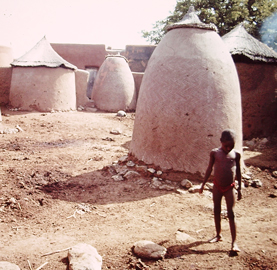
Central bui in the cattle yard
Although in recent times more maize (cholimbein or chulimbein) is cultivated than millet, some decades ago millet was by far the most important crop, which was cultivated on fields close to the homestead under the direction of the field owner who was usually also the head of a homestead (yeri nyono). The harvested, unthreshed millet was placed into the millet granaries (bua, sing. bui), which are often located centrally in the cattle yard.
At regular intervals or when the wives of the homestead ask for it, the landlord allocates his wives a supply ranging from enough for two weeks up to a few months.
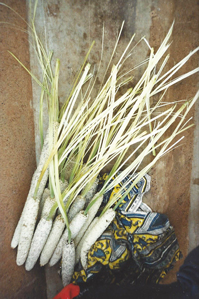
A bundle of milletI received

Garden
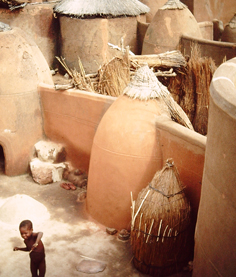
A wife’s mud store with a straw lid in her courtyard
In the past, many of the sauce-ingredients were collected as wild herbs or fruits, and even today this way of obtaining food may still be common for many leafy vegetables (e.g. bogta and tree leaves).
Sometimes older sons of married women create gardens (gaaden) from sixty-four to one hundred square metres in size, which are artificially watered by a nearby well in the dry season and which supply their mothers or wives with sauce ingredients. In Anyenangdu Yeri, for example, in the years 1994-2011, the following vegetables and spices were grown in 3 to 4 dry-season-gardens: cassava (banchibik, Manihot esculenta), coco yams (mangkain, Xanthosoma mafaffa), sweet potatoes (nabanyuiri, Ipomea batata), aso(w)aaka, aleefu (Amaranthus spinosus and Celosia trigyna), okro (ngmaana, Hibiscus/Abelmoschus esculentus), red pepper (ngmaribazung, Capsicum frutescens), climbing beans (felik tue), tomatoes (kamantos, Lycopersicon esculentum), bananas (kooduta, sing. kooduk, Musa sapientum), plantains (boadie, boaderi, Musa paradisica) (pineapples (abrobe, Ananas comosus), felik kinkari (sugar cane, Saccharum officinarum), turi (pl. tue, beans) with tuita (bean leaves) and kazaksa (kenaf, local hemp, Hibiscus cannabinus). In addition, the small dry-season-gardens are used to grow tree seedlings that can be transplanted later: mango (manggook, Mangifera indica), Pawpaw (burferi, Carica papaya) and others.
Some sauce ingredients can only be bought at the local market. These include, for example salt (yesa), small, dried saltwater fish (biila), local Maggi, which nowadays is produced in factories in Accra and Kumasi (J.Ag.).
According to J. Agandin it is an “old tradition … that every wife of the homestead owner usually gets what we call a ‘backyard’ or ‘nangaang‘ for growing whatever they wish. This is one of the reasons why grown up sons may wish to relocate and build their own homesteads. If they continue to live in their father’s homestead, their wives will not be allocated backyards”.
On these plots the wives may grow crops for their own household with the help of their sons or hired farm workers from the neighbourhood. In such a case, the un-threshed millet is stored in the woman’s mud store which is located in her courtyard wall facing the cattle yard. However, women with small children or those who do not yet have adult sons who could work for them receive their millet allotted by their spouse at intervals.
My childless cook Agoalie did not receive any grain at all from her husband, Anamogsi, but covered all her needs with the harvest produced from her own field. She did not pay her farm workers for the working day, but cooked hot meals and provided them with drinks .
1.2 Preparing and taking meals

Two relatives eating kaponta with spoons
The wife is responsible for preparing meals. She may be assisted by her unmarried daughters and sometimes a doglie (i.e. a maid servant from her own kin). Her children eat in a courtyard corner or in a house (dok) separate from her.
Although I was told earlier that the taking of food from a single bowl (kpalabik) by several persons occurs in a fixed manner, this assertion could not be confirmed by my own observations. Also J. Agandin remarks that my observations refer to polite and orderly eating among adults. Children and young people usually cut any side of the TZ that they feel is cool enough, even on the side of the other person.
When only two people eat from one bowl (as I sometimes did with my former co-operator, Leander Amoak) or, as it happens, in a more modern monogamous household with husband and wife, they both take the food from opposite sides of the kpalabik with their right hand, then dip it into the sauce bowl (cheng) and push it into their mouths with their thumbs. Even today, saab a type of porridge made from millet and in recent times also from maize as well as fufu (sakori or nyue-saab), which consists of boiled and pounded cassava or yam with plantains, are eaten almost exclusively with the hands, even in posh restaurants in Bolgatanga by diners wearing dark suits.
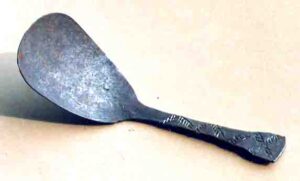
Duisuk (iron spoon)
Rice, beans and other dishes are now more often eaten with a purchased metal spoon. In the past, the residue of millet water (zom) at the bottom of the calabash bowl could also be spooned out by the drinker with an iron spoon (duisuk) made by the blacksmith or with the hard leaf of a tree. Eating with knife and fork is not common in traditional homesteads. The traditional norm is that all wives serve their husbands a hot meal at noon and in the evening. The wife expects him to eat at least part of the meal from her bowl and is proud when he has taken a large portion. She takes the rest of the meal back to eat with her children.
This traditional form of food distribution is often not followed. For example, in my homestead, Anyenangdu Yeri (Wiaga-Badomsa), only the four youngest wives set out hot meals for their husband and landlord (yeri nyono); all the others cooked only for themselves and their children. J. Agandin explains this in the following way: “When a man has several wives, the older ones are more likely to have many children and so the man made reduce their burden by telling them to stop serving him so that they younger wives who still have fewer children can take up the task”. Especially in modern households, the preparation and distribution of hot meals is often arranged individually. Out of the four widows of my late co-operator, Leander Amoak, the eldest widow, who had worked as a bread baker, no longer cooked at all but received her hot meals (similarly to a husband) from the other three women.
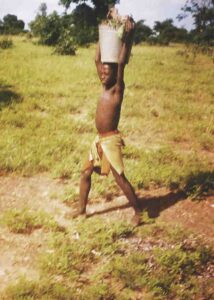
Collecting miedi clay
After the marriage of my co-worker Danlardy (son of Leander), his biological mother no longer cooked for him. However, after his wife had children, his mother resumed cooking for Danlardy and his family again “out of necessity and courtesy”.
In a traditional household, if an adult son does not have a wife and his mother is still alive, his mother will continue to cook for him and expects him to work her field in return. However, she does not bring the hot meal to her son’s home as she does with her husband. Rather, the son fetches the food from his mother or a small child brings him the hot meal. If the mother has already died or left her husband, sometimes the wife of one of his brothers cooks for him out of pure courtesy. But I also know of cases where such men prepare their own food or buy it at the market.
Agoalie, an older, childless wife, cooked only for herself and me. The portions she served me for lunch and dinner were so big that they could not be eaten by one person. The rest was for Agoalie herself and at times for her doglie.
According to information from Gbedema, all women who have their own courtyard cook for themselves and their children. The husband announces beforehand with whom he wants to eat.
A particular situation pertaining to food preparation was reported to me from Wiaga. In one household, one of the four wives also cooked for the other women’s families every day. However, this practice has been criticised by outsiders.
According to J. Agandin it is not so strange. “Usually it is the result of very good relations between co-wives. In our house in Balansa, each of my two step mothers used to serve our compound a bowl of food and my mother also serves them when she cooks. Even when each woman has cooked her own food, she will still get a bowl of food served to her by her other co-wives”.
Occasionally, women cook hot dishes for market sale, or they bring them (for a fee) to neighbouring houses. In the latter case, these are often dishes that not every Bulsa woman can produce, for example kenkey made from fermented maize, which is popular in southern Ghana. Moreover, millet and bean cakes (maasa and koosa respectively), which are rarely baked in one’s own homestead, are offered by a woman from Badomsa to other homesteads.
Daughters-in-law very rarely cook for their father-in-law. If they live in a polygynous family, the same rules as outlined above apply to them.
There is usually a great willingness to cooperate among the wives. For example, if one woman wants to make shea nut butter, other women help to crack the nuts and grind them on the grinding stone. They are not remunerated, but the helpers expect to be helped with similar work later. The principle of reciprocity is also applied to many other activities, for example plastering walls or renovating floors.
Breakfast traditionally takes place after the miedi. This is when the termite earth from a termite hill has been collected in the bush to feed the chickens. If there are school-age children in the family, the time school starts (8:00 a.m.) and the duration of the trip to school both determine the time of breakfast. In traditional homesteads, this consists of, for example, a calabash bowl with kaponta or kooko, which are fermented, viscous by-products of millet porridge preparation.
In the modern house of Danlardy Leander, breakfast takes place between 7:00 and 7:30 a.m. and may consist, among others, of the following dishes: Millet water, pumpkin (peri), kenkey, rice (although the parboiled rice has to cook for 45 minutes), kooko and/or banku, and, more rarely, kaponta. They buy the last two dishes at the nearby market, although Danlardy’s wife can prepare either herself. Lunch is between 1:30 and 2:00 p.m., which means after school. Only in the evening around 7:00 p.m., i.e. after dark, is there a hot meal served; this is usually saab, rice, kenkey or banku. Beans can be cooked in the soup or eaten separately. Meat ingredients for the sauce are rare and may, for example, consist of portions of an animal sacrifice made by the head of that family.
2. THE MAIN MEALS: SAAB, RICE, TUBER CROPS
2.1 Saab (a type of millet porridge)
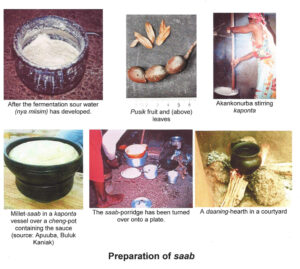
M. Fortes, who gives a brief description of the preparation of millet porridge (Tali: saγab) among the Tallensi (1936: 265f.), remarks:
The preparation of porridge is very simple… The time taken to cook a potful of porridge sufficient for 10 people is only about 10 minutes…
Even if the time mentioned refers only to the last phase of the work and excludes the mashing, grinding and the preparation of the sauces, it seems to be too short when applied to the preparation of the saab of the Bulsa. The longest and most difficult phase of the work is always before the preparation on the stove. We only need to mention the procurement of firewood, the threshing of the millet in the mortar and the grinding of grains in the milling room.
The preparation of millet porridge by the woman has been described in detail in BULUK 9 (39-42). [endnote 1]
The pure kitchen work of making saab usually begins a day before it is eaten. The cook puts some millet flour with water in a bowl the evening (or even a longer time) before, and by the next morning, a slight fermentation has begun, the water having become somewhat slimy and sour. This fermentation “produces a better quality millet TZ. If this step is skipped, the TZ would be poor quality and cannot be left overnight and still be in good condition. The taste too would not be the same and may upset the stomach. For maize, this step is not required” (J. Ag.).
This fermentation does not always succeed, however. In fact, some women are almost never successful in starting it even if they mix the millet water vigorously by hand. In such cases, the cook can ask another woman, e.g. a helper (doglie) or a daughter, to stir the millet water using her hand. According to Margaret Arnheim (Gbedema) it is possible that the microorganisms necessary for fermentation are transferred from the hands, which could also explain the varying effectiveness of hand-stirring.
J. Agandin remarks on this process: “…Even in cities like in Tamale, Bulsa women and those from Upper East region in general still prepare ‘nya-miising’ even without using hands or adding other things. The millet water is typically kept longer than the one night. It is always remixed after use and so the residue from the previous one helps in the fermentation”.
Bulsa women who want to make their traditional millet porridge in Europe (possibly from coarsely ground maize as an alternative) almost always have difficulties getting the millet water to ferment in one night. This is probably due to the preservatives in the flour, the strong disinfection of the tap water or the sterile environment in general.
Creating a sour taste in the millet porridge can also be brought about in other ways. The Bulsa form small balls from the de-husked [and mashed?] fruits of the pusik tree (Tamarindus indica), which can also be bought at the market at this stage of processing. Boiled in water, the fruit gives the water a sour taste similar to lemon water. This solution (nya-miisim, “sour water”), which is certainly rich in vitamins, is drunk as a refreshing drink, given to sick people or added to the still-cold water intended for preparing millet porridge. This is especially necessary when the flour is no longer quite fresh, i.e. it has had a long storage time.
A certain time before the meal, plain water or the fermented millet-water is brought to a boil on a three-stone cooker. In a clean calabash (chin pielik), most of the millet flour needed is mixed with the water to make a thick paste. According to Margaret Arnheim, it is important that this paste has the right consistency. Otherwise, the whole millet porridge will be spoiled (kasi) and the result will be a “dead porridge” (sa-kpiuk?). The paste is stirred into the boiling water, and it should continue to boil for some time. The result is an intermediate product called kaponta, which may be consumed in this form. In the past, it was probably always eaten without any additional ingredients, but today people sprinkle a little sugar into the liquid porridge if available.
If the cook wants to make solid saab porridge instead of kaponta as her final product, she ladles a little less than half of the kaponta out of the cooking pot into the calabash bowl that has been rinsed out in the meantime and places it near the fire so that the contents do not cool down. With her hand she now sprinkles dry millet flour into the cooking pot on the stove, and with the sapiri stirring stick she mixes it with the boiling kaponta, stirring vigorously so that as few clumps as possible may form. The cook also has to make sure that the consistency is right. A millet porridge that is too firm is called sa-giri-ba nyuok (literally: millet porridge that makes the intestines hard), according to M. Arnheim, and is considered undesirable unless the consumer suffers from diarrhoea. Finally, the kaponta set aside in the calabash bowl is poured back into the cooking pot while stirring, and everything together boils up thoroughly once more.
The eating vessels, dark clay bowls (kpalabsa) or red-brown calabash bowls (chin-moansa), are rubbed with shea butter on the inside or – alternatively – at least moistened with water before filling so that the porridge does not stick to the bottom. It is poured with a ladle or a small calabash bowl in individual portions, which are poured out into flat pancake-like layers in the eating bowl. Some cooks coat each new layer with oil or water or at least rinse the ladle with water after each portion so that the layers can be easily removed when eating. If the bowls are filled, the surface of the millet porridge and even the outer bowl walls can also be rubbed with fat to give them a shine, i.e. an appetising external appearance. After filling, the porridge should first cool for a few minutes before it is covered with a lid. Otherwise, according to M. Arnheim, it could spoil, especially in the hot season. When serving, however, the porridge should still be hot; cold porridge is said to be difficult to digest. If a part of the meal is left over, it can be reheated and eaten at a later time. However, it is considered cold food and for some people it is inappropriate or undesirable.

Men eating sa-gaang; in front: the stirring stick consisting of two millet stalks
Sa-gaang (a variant of TZ)
Cooking is typically a woman’s occupation, and no man will help his wife with any work in the kitchen. Nor would the wife allow it. It is all the more astonishing that men sometimes prepare entire meals on their own, even if this is done mainly in the ritual sphere, e.g. in juik and vayaam rites.
The product of the men’s cooking is called sa-gaang. “Its preparation in not necessarily a man’s domain. Sa-gaang is also regularly prepared as an afternoon meal especially during the farming season and this is usually done by women. In this case it is not made from the broth of boiled meat or blood but with plain water and then spiced with salt and pepper and softened/moistened with shea butter… The reason the men use sa-gaang is mainly because it is quicker to prepare…They do not have the time and courtesy to prepare real saab, so they prepare what is easy to make and also because they do not really care about finesse…
The reason is not religious at all. The only other consideration is because they do not want to contaminate people who have no connection with the juik deity. Sometimes women are unwilling to lend the men their cooking utensils because of the fear of contamination, by which I mean that if the utensils are not properly washed and another person eats from them, they may be haunted by the deity…”(J. Agandin).
When on 8 February 1989, a red-brown dog was sacrificed to the mongoose deity (juik) of Abasitemi Yeri, men collected the blood in a bimbili pot and put it on a fireplace in front of the homestead. They cut up the meat and boiled it in a samoaning pot on the fire of another three-stone hearth. Salt (yesa) and kaam (a filtered extract, which is a kind of “local vinegar”) were added as seasonings to both dishes. After the meat was cooked, one man removed it from the clay pot along with some of the meat broth and poured dry millet flour into the pot, stirring with a simple millet stalk until a paste-like porridge was formed. Another man sprinkled flour into the boiling dog’s blood on the second hearth until a second, reddish-brown millet porridge formed. After the cooked food had been sacrificed, the blood-sauce was only eaten by the owners of a juik shrine and those who were dedicated to a juik deity in their segrika naming ritual. The children of juik owners were also allowed to eat some meat. This distinction may also be the reason that blood (along with the liver) and meat were cooked in different pots.
In another juik ritual (juik-yierika) in Anyenangdu Yeri, the making of the sa-gaang was similar. However, in addition, the officiant hurled pieces of the millet porridge from the stirring stick in several directions. In this way, the other juisa (pl.) of the homestead could also share in the meal.
Apart from juik rites, sa-gaang seems to be customarily prepared at rites associated with vayaam, the gravedigger’s medicine. At the presentation of this medicine in Wiaga-Chiok to my assistant, Danlardy and to me (cf. BULUK 12, pp.77-79), portions of sa-gaang and shea oil were smeared on an unworked wooden stick and this food received sacrifices later. Before we (as well as others from the homestead) consumed it, the saab in the cooking pot was mixed with the powdered vayaam medicine.
In the preparation of sa-gaang that I could observe there was no pre-dawn fermentation and no kaponta stage before flour was sprinkled into the liquid. There were also qualitative changes. For example, the sa-gaang contained the taste of meat or blood due to the broth, and it was seasoned with salt and kaam, while the usual saab does not contain salt or any other ingredient.
2.2 Other grains
Rice (mumi, pl. muma; Oryza sativa or Oryza glaberima)
VARIETIES OF RICE
| TRADITIONAL | |
| Local Rice | |
| swamp rice | white; not traditionally grown by Bulsa) |
| mountain rice | red; most common in Africa; sown two weeks before white variety, they ripen at the same time |
| Kadema White | tall plant, short grains |
| INNOVATIONS | |
| RR20: | many subspecies; not grown by Bulsa smallholders, only in large plantations, for example in Gbedembilisa |
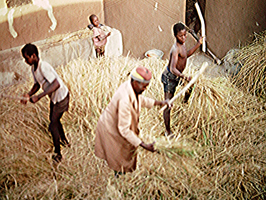
Threshing rice

Winnowing
In recent times, rice dishes have offered a welcome change from the predominant millet and maize dishes.
Rice is sown in seed holes, with a woman placing about 10-15 grains into the hole drilled by a man with a sauk (planting stick).
When harvesting rice, often only the upper panicles are cut off during the first stage. Later, the stalks of one seed hole are grasped with the left hand and cut off with the help of a sickle. After the harvested panicles have dried out, some of them are threshed with sticks in the homestead. Here, too, the working technique differs somewhat from that of millet threshing. The worker takes a bunch of rice in his left hand, holds it on the ground and beats the panicles with a stick. After this he may also hit the tuft against a house wall and then shake it out until the last grains have come loose.
J. Agandin commented on this description: “In Sandema, we typically use the same technique [as with millet]; we gather them in a heap in the courtyard and pound with sticks amidst singing until all the seeds come off. But women do not typically pound them in a mortar as they do millet”.
The technique of parboiling (muma wiaka/yuaka) is also practised by the Bulsa. The unground grains, still enclosed in the husk, are soaked for a day and then cooked in boiling water until the yellowish husk leaves take on a light colour. Then they are dried in the hot sun, ginned in a large mortar and winnowed (yeling or yiinti). The husks can at most be used as pig feed.
To prepare a hot meal, the rice is cooked in large aluminium pots, ladled into kpalabik vessels or plates and served with sauces similar to those used for millet dishes.
Rice is served loose (mum-bie) or in the form of “rice-balls” (rice dumplings, mum-pigma). In Europe, the Bulsa women use pudding rice for this purpose as the soup rice common here can hardly be formed into dumplings after cooking.
As the stalks are relatively soft, they can be used, for example, to make mattresses or soft though not very durable carrying pads (tuilisa).
Rice plays no role in ritual life, which means that: it cannot be sacrificed to the ancestors and other divine beings, there are no taboos or first-fruit sacrifices, and it can be sold without restriction on the open market.

Riceballs ready to be sold at the market
Wiiti (wheat)
Wheat is not cultivated by the Bulsa, but it can be bought in Bolgatanga and Sandema and recently in almost every village, e.g. for baking bread. Occasionally, especially in times of need, donations of wheat reach Bulsaland, probably from the USA and Canada mainly.
When my (male) neighbour in Sandema-Kobdem invited me to join in his wiiti-food consisting of rather hard grains without any sauce, he told me that he had cooked the grains only in salt-water.
J. Agandin, however, remarks that “wiiti is usually spiced. It is cooked like rice and spiced with salt, pepper and pounded groundnuts. It is almost impossible to conceive a meal in Bulsaland eaten without some spice or other”.
Wiiti is considered a typical bachelor’s meal because it is very easy to prepare and almost impossible to fail.
Because the wheat grains are about the size of the small Bulsa beans, the term tue is also used for the former.
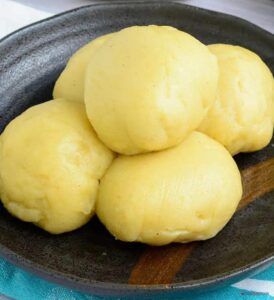
Fufu balls (Source: Daniel Adu, Buluk Kaniak)
2.3 Fufu (nyue-saab or Hausa sakori)
In recent times, southern Ghanaian fufu has started being produced in Bulsaland and can be ordered in Bulsa restaurants. It consists of cooked cassava and plantains which have to be pounded in a mortar for 20-30 minutes. Water is added until a slightly sticky mass is formed. In contrast to the usual kitchen roles, men sometimes help the cooks with the pounding.
In southern Ghana, light soups and palm nut sauces are the main sauces served with fufu, while in northern Ghana I have observed that groundnut sauce seems to predominate.
Fufu is still rather rare in traditional homesteads as the amount of work is quite great and the ingredients were not offered at the smaller village markets (in 1988).
2.4 Kenkey (dakunung) and banku
Kenkey is a fermented maize food found in southern Ghana and is popular throughout West Africa, especially in coastal areas (Wikipedia). It is sold as round or cylindrical dumplings wrapped in maize leaves.
In traditional Bulsa homesteads, its production was still very rare in 1988. However, a woman from Anyenangdu Yeri had learnt its preparation (in southern Ghana?) and sold the finished dish in neighbouring homesteads. Today (2022) it is sold in nearly every village market, probable because maize is now produced in abundance throughout Buluk (J.Ag.).
“A variant of kenkey is banku, a dumpling also made of leavened maize but not cooked in a banana leaf” (Wikipedia). It can also be made from a mixture of maize and cassava.
2.5 Tuber crops
Of the tuber crops, only yams (Dioscurea cayenensis, Buli: nyuri, pl. nyue) and sweet potatoes (Ipomoea batatas, Buli: naabanyuiri, pl. naabanyuira) are normally offered at larger Bulsa markets. However, almost all Bulsa women are probably able to prepare dishes from tuberous fruits. The water used to cook these tubers is poured away. It is not known that this water can contain toxins found in some yams and, especially, cassava.
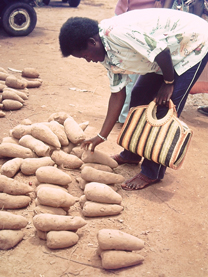
Buying yams on the market
2.5.1 Yams (nyuri, Pl. nyue)
Only a few farmers (for example in Sandema and Chuchuliga) grow small quantities of yams, most of which they probably use for their own consumption. Their low prevalence in Buluk might perhaps be due to cultural or climatic factors or the lack of knowledge in yam cultivation.
Climatic conditions are probably not a very decisive factor for their low prevalence in Buluk, because, among the Koma, a neighbouring ethnic group of the Bulsa, yams are part of the “staple food” along with millet dishes.
Its cultivation, which I could observe only sporadically in Sandema-Kalijiisa, does not seem to differ much from that in the yam belt of Ghana. After the planting mounds have been heaped to a height of about 80 cm, a piece of the tuber is planted in the mound and a flat stone is placed on top of the mound.
To prepare yams, the cook peels a tuber, cuts it into pieces and boils it in an aluminium cooking pot.
Yams are not served with one of the sauces usually reserved for millet or maize dishes but, if it is available, with a palm oil sauce, which is not common in Buluk. “Traditionally yam slices are served with salt and pepper stewed in shea butter” (J.Ag.). Otherwise, it is served with a sauce made from shea butter fat and usually has a reddish colour due to the added pepper and tomatoes. The sauce is poured over the yam pieces, and everything is usually served on a porcelain or tin plate, if available. As a side dish beans (tue or suma) can be offered on the same plate. After cooking, yams can also be mashed and served as “mashed yams”.
Although the Bulsa do not regard yams as a native crop, in Sandema the new crop must not be consumed until the shrines of the compound have received their first fruits offering. It is prepared with the first fruit offerings of the new shea butter. A slice of the cooked yam with some shea butter is placed on each of the shrines of the homestead as an offering. Yams may also be ritually used, such as in the distribution of hot meals at the juka funeral celebration, although no dishes made from rice, sweet potatoes or even maize are permitted on such an occasion.
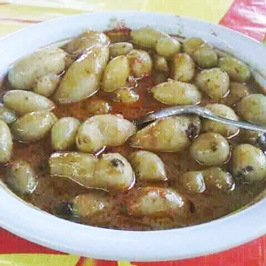
Piesa (Frafra potatoes); source: Buluk Kaniak
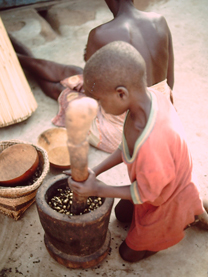
Piesa being peeled in a small mortar
2.5.3 Hausa or frafra potatoes (piesiri, pl. piesa, Coleus dysentericus and Coleus rotundifolius?) and sweet potatoes (naabanyuira, Ipomoea batatas)
I have received different pieces of information about the cultivation of these rather small tubers. According to one report, leafless stems, around 20 cm long, are planted in raised beds. The upper half soon withers and tubers form on the lower half. After 4-5 months, the tubers can be harvested. In 1988, the harvest in Wiaga took place at the beginning of October, which was before the harvest of maize, groundnuts, rice and late millet.
The tubers undergo a processing similar to that of yam. The smaller, unpeeled, cooked frafra potatoes are usually eaten immediately after harvesting as there are probably only imperfect storage facilities. They are washed, skinned in a small mortar and processed very carefully with the pestle, cooked and then eaten with salt, pepper and fat (kpaam) as a snack. (J. A.;) They can also be skinned individually after cooking and thrown into the mouth.
Boiled sweet potatoes and frafra potatoes must not be sacrificed to any shrines or used in meals for guests at funeral rites.
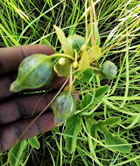
Bumbota; Source: Angaaba Atesiuk, Peter (Buli Zamsika)
2.5.4 Bumbota tubers (sing. bumbook)
The bumbota tubers, which are only collected from wild plants in the bush, are considered a special treat. Usually the number of tubers collected is not enough for a complete meal, and the cooked tubers are eaten with or between meals. Bumbota can also be dried and ground and thus preserved for a while. Unlike nabanyuiri and frafra potatoes, bumbota can be used to feed guests at funeral ceremonies.
On the third day (Siira manika dai) of the juka funeral celebration, when relatives are presented with hot dishes according to a set plan, people like to place a cooked bumbook tuber on the clay pot with saab.
3. THE SAUCES (JENTA) FOR MILLET/MAIZE PORRIDGE
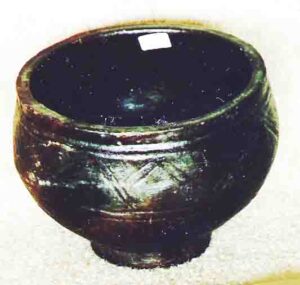
Bimbili
The traditional millet porridge (saab) allows the cook only a small degree of variability. It can be fermented or unfermented and made from early millet (naara), late millet (za–piela) or sorghum (za-monta). In addition to a slight change in taste, this can also change the colour because the porridge made from naara and za-piela has a greyish colour while that made from za-monta is usually reddish-brown. It is in preparing the sauces/soups (jenta) that the cook can show her wealth of imagination and her ability to offer a varied kitchen menu.
Both English designations for Buli jenta (soup and sauce) are inaccurate. Soup is not correct since jenta is not consumed as an appetiser or independent dish. But the term sauce does not quite fit either since, according to common usage, it is understood to mean a liquid that is poured over or mixed with another dish. A piece of millet porridge is dipped by hand into the bowl of sauce before being eaten. However, since jenta is understood as an addition to another dish, I think this term sauce is more appropriate.
The cook prepares all the sauces in a bimbili clay pot on the fire. She brings the water to boil and stirs the various ingredients into it. Meat and fish (apart from biila) are by no means part of the daily hot meal. However, if they are used, they are also cooked in this water. When, after a sacrifice, the blood of the larger sacrificed animal (dung: dog, goat, sheep or cattle) is collected in a pot, it serves directly as the liquid for the sauce. For everyday-meals the housewife does not use the blood of an animal for cooking regular jenta (J.Ag.).
Besides salt, almost all soups receive kaam, a liquid that has taken on a bitter-sour taste after passing through a filter pot with ash (kaam-soluk). The main ingredients for everyday sauce come from the plant kingdom and consist mainly of fruits (seeds, pulp, pods) and leaves. These ingredients are obtained from both cultivated and wild plants and consist of
vegetables and spices. Some sauces are mainly vegetable-based and others are mainly spice-based. Many of these sauces are also said to have a therapeutic effect (cf. Kröger 2019: 58-88).
The most common vegetable sauce ingredients are enumerated in the following chapters.
3.1 Fruits (seeds, pulp, pods) and their processed products
3.1.1 Cultivated crops
Groundnut / peanut (sungkpaam, Arachis hypogeae)
VARIETIES
| Name | Harvest; ripening | Description |
| TRADITIONAL | ||
| Local groundnut | ripening time: 4 months, harvested with a hoe | now rare, difficult to open, but easier to digest raw than imported varieties |
| Sungkpaam diok: | harvested with a hoe | three nuts in one pod, |
| Sungkpaam sumi | harvested with a hoe | plant resembles the bambara bean |
| Anawuura: | harvested with a hoe | |
| INNOVATIONS | ||
| Chinese variety | ripening time: 3 months, harvested by extraction | now the most common variety |
| Manipinta | harvested by extraction | thick shell looks white and unripe before harvesting |
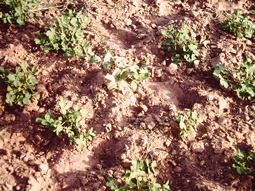
Groundnuts intercropped with round beans
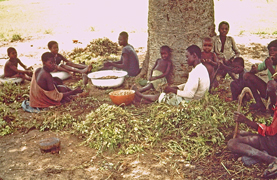
Removing the harvested groundnuts from their stalks
Groundnuts are usually sown in seed-holes after a big rain shower, usually in July. The sowing of commercially grown groundnuts is usually carried out a few weeks earlier. Just before sowing, women remove the shells by beating the nuts on hard ground to separate the shell from the kernel and then select the best fruits for sowing. Groundnuts can be intercropped with other fruits, for example round beans (suma). After one week the groundnuts germinate and after about six weeks they flower.
With regard to the exact date of sowing, farmers with writing skills write it down while illiterates simply make a mental note. About two weeks before the presumed ripening time, a first sample and a week later a second are checked.
To harvest groundnuts, farmers, children and other helpers pull the plant out of the ground with their hands or use a hoe (see table) and clean the bunch by beating it on the ground.
Freshly harvested groundnuts are difficult to digest and are therefore roasted over or under a small fire if needed immediately. Pre-cooking or roasting is not necessary if the groundnuts are to be used to make a sauce. The shells are removed and the nuts are pounded to a thick paste in a small mortar (jenta tuik) and then boiled in water. In recent times, many women have the groundnuts needed for making sauces ground in the nika-nika mill.
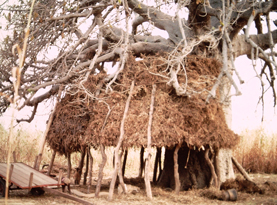
Groundnut-stalks in front of a compound
Groundnuts are always sold, bought and stored in shells, but they have generally not been boiled in salted water. “Only in cities and towns do people buy boiled groundnuts from hawkers” (J. Ag.).
Groundnut sauces are considered nutritious and healthy and are popular as meals for sick people or women who have just given birth.
If, for example, after elaborate sacrifices, several types of meat are offered to the participants, groundnut sauce tends to be served with chicken meat and saab, while a blood sauce is served with the meat of larger animals. If the offerings consist of only chicken and guinea fowl, groundnut sauce is usually prepared for the chicken meat (kpiak) and okro sauce for the guinea fowl meat.
Although newly-introduced fruits are usually not allowed to be used for sacrificial purposes, new varieties of groundnuts, e.g. the now commonly cultivated “Chinese groundnut”, can be used as an ingredient for sacrificial sauces.
Processing the groundnuts into oil, which in turn can also be used as a soup ingredient, is rare and does not seem to have a long tradition among the Bulsa. After removing the shells, the nuts are roasted and then usually ground in a mill (nika-nika) driven by a diesel engine. The product of the grinding process, a soft paste, is stirred with a sapiri stick into water boiling in an aluminium pot or chari clay bowl. During boiling, the oil escapes and accumulates on the surface. It can later be skimmed off with a metal or calabash ladle (duisuk kpiong) and stored in a smaller clay vessel (e.g. bimbili) or in a tin bowl (taasiri).
Okro (ngmaana, Hibiscus esculentus or Abelmoschus esculentus) Okro plants are grown near homesteads or in a dry season garden. The pods can be used fresh just after harvest or in a dried state as a soup ingredient. To prepare sauces, the cook slices the pods, mashes them with other ingredients in a small mortar (jenta tuik) and cooks them. Together with pounded groundnuts (sungkpaama), kinkana (flour made from unripe millet grains), baobab fruit seeds (chikpigla) and kampuuling seeds, okro can be made into a popular sauce called porung. Meat or eggs can also be cooked in the okro sauce.
All okro sauces except the variety that ripens with the bean leaves (tuita ngmaana) are often used for sacrifices to supernatural beings.
Wiiga (fruits of Hibiscus sabdariffa) and wok-nankoli: From the subspecies wog-moanung (moanung = red) and wog-pieluk (pieluk = white), the leaves and the seeds (wiiga) of the pods are used as food. From the subspecies wok-nankoli, both the leaves as well as the whole fruits with pods are eaten (koli = pod?). They are popular as a soup ingredient, especially with children, who see them as a kind of meat substitute.
(See also chapter 5.3: round beans)
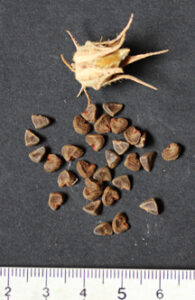
Wiiga fruit and seeds
Pepper (ngmaribazung or ngmazung, Capsicum frutescens)
The red peppers are dried after harvesting and usually stored in a clay pot. Before consumption, a woman grinds them into a coarse powder which she not only uses as a sauce ingredient but which is also almost always an ingredient in millet water (zu-nyiam). Most Bulsa love hot sauces flavoured with pepper, although they themselves say that their sauces are less hot than the kenkey sauces of Accra. Almost all “deities” worshipped in shrines (bogluta), however, abhor pepper-spiced sauces in their sacrificial food.
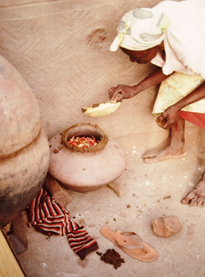
Pepper stored in a ceramic vessel
Neri, Egusi (buura, Cucumeropsis edulis? Fortes: Cucumis melo)
Neri or Egusi is a pumpkin-like fruit which is intercropped with millet. Only the seeds are used as ingredients for soup.
The seeds needed for a meal are pounded in the small mortar before cooking. The shells of the seeds are very soft and therefore do not need to be removed. Unformed, mashed buura seeds can be cooked directly in soup, or they can be formed into small balls called buu(ra)–kukula. As they keep for only one day, this is probably why they are not on offer in the markets. After mashing, the woman may also mix and knead the seeds with her hands and strain them through a sieve (nowadays usually a flywire). Added to the sauce, it becomes light in colour and looks like egg soup. The rest of the buura fruit (the pulp) is not used as human food.
Similar to buura seeds, though far less common, calabash seeds are processed as a soup ingredient in a similar way.
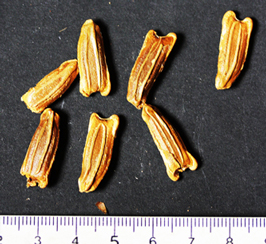
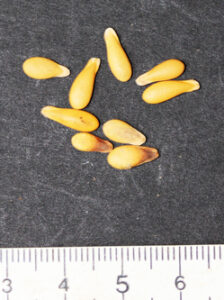
Millet flour: zom and kinkana
Grains from immature or otherwise poor-quality cobs (za-gunta) of early millet cannot be used as seed and are rarely used to prepare millet porridge. When ground, they serve as a binding agent in certain sauces under the name kinkana. Such a soup with kinkana or bean flour is called porung.
Tomatoes (kasmantos, Lycopersicon esculentum)
Tomatoes are very common soup ingredients, especially in more recent times, but are rarely eaten raw or as a cold cut for a slice of bread in traditional homesteads. Younger men in particular grow them in dry season gardens. But they can also be bought at the market.
Koma (sing. komi, local garden eggs or aubergines; bitter tomato)
These red or green fruits look somewhat similar to tomatoes but taste like bitter aubergines. They are traditionally eaten raw.
3.1.2 Fruit of wild plants
The dawa-dawa spice jong
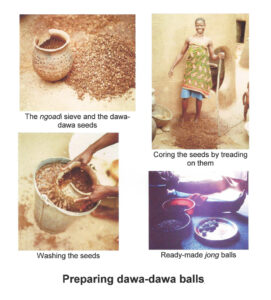
Among the most commonly used soup ingredients are small flat dawa-dawa balls (jongsa), made of the seeds of dawa-dawa pods, which are harvested in September from dawa-dawa trees (duesa, sing. dueb). These spices can be used for almost all sauces including those of leafy vegetables (e.g. tuita bean leaves, baobab leaves and others). To make the sauce for four people required in the observed cases between one quarter up to two jong balls.
Other parts of the dawa-dawa fruit are used. Women sometimes offer a guest a pod containing the yellow powder (du-buulim), which is considered a delicacy by many Bulsa. After consuming the powder “the seeds and pods are collected in a calabash given to the guest for this purpose” (J.Ag.). The woman will use the former to make jong and the latter to make ngam, a strengthening (hardening) agent for a new clay plaster.
Not every housewife can make jong, but the woman most adept at it often passes on her knowledge and skills to other women of the homestead. The female producers remove the seeds, mix them with coarse sand in a chari clay bowl, pour them onto the smooth floor screed of the courtyard, and core them by treading on them with their bare feet. Afterwards, they pour some handfuls of the seeds into a ceramic ngoadi sieve pot and move it around in the fresh water of a larger vessel (e.g. a bucket) until the seeds are completely clean. Then they are cooked and formed into small flat balls.
Jong is often stored in the small yalung baskets (see Kröger 2001: 334-336), which are often placed high on a wall or in the kitchen to keep them safe from rats and other vermin.
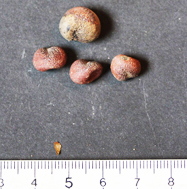
Baobab seeds
Seeds of baobab and kapok fruits
A baobab fruit provides the cook with white pulp containing edible seeds. She crushes the pulp in a small mortar and stores them in a calabash or clay pot after removing the seeds. On occasion, the white crushed powder provides a refreshing, appetising drink when, along with perhaps a little added sugar, dissolved in water. The white powder can be bought at the market and is even sometimes exported in bags to southern Ghana.
The seeds (chikpigla) are also crushed in a small mortar to a coarse, beige-coloured flour. The female producer sifts this through a fly wire into a calabash bowl. It can be added to many sauces, for example to all porung soups, wokta, kazaksa etc., but also to the viscous kaponta millet dish.
The whole seeds can be cooked together with round beans (suma) as a separate dish. Because of their longer cooking time, the chikpigla kernels are pre-cooked and the round beans are added later.
The unground seeds of baobab can sometimes be bought in markets. Baobab flour (tu-buulum, tu-buulim or tu–kpegla) is also used as a substitute for millet flour, especially in poorer families or in times of hunger. Our statements about baobab fruit kernels also apply to a large extent to the kernels of the kapok fruit (gunggung bie).
Fruits of the red-flowered kapok tree (voong, voom, Bombax buonopozense)
The fruits (voom-ligsa), which look like small red apples, are sliced and dried on the flat roofs before being used as a soup ingredient.
Fruit of the water lily (gumi, Nymphea lotus)
The cook removes the soft fruits of the water lily with their poppy-like seeds and chops them up to add to a soup. Often the seeds are eaten raw (J.Ag.). The cooked fruit (gum-digma) can also be eaten as a small snack without any other food.
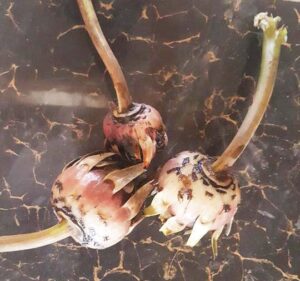
Fruit of water lily (guma)
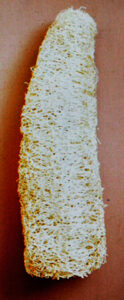
Sapok (massage sponge)
Sapok fruits
The fruits of a climbing plant called sapok or soosok, which is sometimes planted to cover the kusung building, yield pumpkin-like fruits that can be used as a soup ingredient when young and green. The reason for cultivating this plant, however, is mostly based on the fact that the ripe fruits provide a fibre mass which, after removing the pulp, is used as a massage sponge in daily bathing (see Kröger 2001: 279).
3.2 Leaves (vaata) as a vegetables
Leaves that are to be used as a vegetable ingredient for the sauce are either dried for a few days or in their fresh state (J.Ag.). Women working in groups cut them into small pieces and throw around a handful of them as a soup ingredient into the boiling water
3.2.1 Cultivated plants
Asowaaka or Suaaki (Hausa)
This plant, which is not indigenous to Bulsaland, is preferably grown in dry-season gardens. Suitable ingredients for an asowaaka sauce with its bitter leaves are mashed groundnuts, gungung bie (seeds of the kapok tree) and/or chikpigla, but not kinkana (flour) and kampuuling. The cooking water of this sauce is poured off after a certain time; it can be used as a medicine against abdominal pain.
Aleefu (Amaranthus cruentus, Amaranthus spinosa: prickly Amaranthus)
Aleefu is grown almost exclusively in dry season gardens. In its preparation and combination with other sauce ingredients (e.g. groundnuts, chikpigli, kampuulung bie) it is similar to wokta vegetables, but the cooking time is longer.
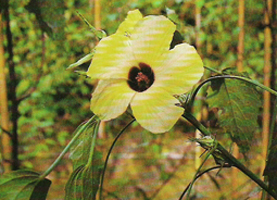
Blossom of kazaksa
Kazaksa (local hemp, Deccan hemp, kenaf, Hibiscus cannabinus)
Kazaksa is grown close to homesteads, but also within millet fields. Its leaves, like those of wokta, play a role as a sauce ingredient. The greatest economic importance of the kazaksa plant probably lies in its function as a fibre supplier.
Kazaksa sauces, in addition to salt and pepper, always receive binding agents in mashed or ground form: groundnuts, kinkana, maize, chikpigla, or kapok fruit seeds (gunggung bie). To take away the bitter taste of the kazaksa sauce and to soften the hairy leaves, kaam is always added.
Ngman-vaata: If the leaves of this okro plant (Hibiscus/Abelmoschus esculentus, see ngmaana) are cooked in a sauce, which becomes slightly slimy, but not to the extent of the okro fruits.
Peri-vaata: The leaves of the pumpkin plant (peri, Cucurbita sp.), which are harder and rougher than those of the calabash plant, are considered a great delicacy.
Tuita (sing. tiuuk) After wokta and ngman-vaata, bean leaves are probably the most commonly prepared leafy vegetables in the sauce. They can also be eaten as a kind of spinach-like vegetable on their own or in the sauce with, for example, buura, kinkana, chulambein, but not with groundnuts, chikpigla, kampuuling or kapok seeds.
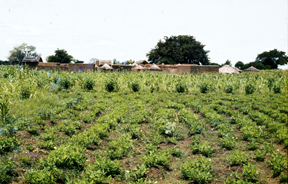
Wogta plants as boundary markers
Wokta: The Guinea sorrel plant’s leaves as well as its fruits (wiiga, Hibiscus sabdariffa) serve as food for the Bulsa. From its tall stems, a fibre is obtained for making ropes. The leaves, whose anti-scorbutic properties are emphasised by G. Franke (1967: 351), give the sauce a slightly sour taste and the plant has therefore also been called African sorrel. These leaves are used very often, and when Bulsa women living in Europe visit their homeland, they sometimes bring a bag of dried wokta leaves back to their host country.
Wokta is sometimes sown shortly after millet and sometimes only after the first weeding. Rows of the tall plants can also serve as boundary markers for the fields of a neighbouring homestead.
The young shoots are pulled by hands, and the removed plants are used as soup ingredients.
When the fully grown plants are about 30-40 cm high, the cook picks off ten or more leaves for the next meal. In her courtyard, she rips them from the stem and tears them before drying them in the courtyard. The dried wokta leaves (like kazaksa leaves at this stage) are not pounded but crumbled by hand and then thrown into boiling water. During the boiling process, the cook changes the boiling water once so that the vitamin-rich water which is poured off can be used as medicine and to strengthen sick people.
Mashed ingredients added to a wokta sauce in addition to salt and pepper are jong (dawa-dawa balls), biila fish, groundnuts, corn, chikpigla, gunggung bie, and/or kinkana. A wokta sauce without groundnuts is called wog-chutok.
Dried wokta plants can be stored in bundles or, in crushed form, in clay pots.
3.2.2 Leaves of wild plants
Bokta (sing. bok or bog, Chinese mint, horehound, hyptis, mintweed, pignut, wild spikenard, Hyptis suaveolens or Mesosphaerum suaveolens)
This very small plant occurs frequently, even near homesteads. Nevertheless, field workers weeding a field close to a homestead are careful not to destroy the wild bokta plants. It is probably one of the most commonly used wild plants for soups and gives the sauce a strong, slimy consistency. For this reason, however, it is rejected by some while others appreciate it more than any other sauce, as is evident from the following oft-quoted proverb: Nandum yeng kan ming bokta masim (One finger alone does not know the deliciousness of bokta sauce). It suggests that only the opinions of many really count.
Jambasueemi: This “weed”, often found in the fields, should not be removed from the soil during weeding because its leaves can be used in soups, making them somewhat slimy.
Kanwok (pl. kanwoksa): This wokta-like plant has broad leaves and long roots. Only the very young leaves are used as sauce ingredients.
Kareba-chiok (Wiaga) or karibanyong, karibanyang (Sandema): The grass-like plant is used for sauce preparation.
Kpong-ji-nyiam: This sauce consists mainly of the leaves of the plant Cleome monophylla or Sesamum indicum (kpong-zu-nyiam). The name (kpong = guinea fowl) is supposedly explained by the fact that the prepared sauce has a similar taste to a guinea fowl broth.
Ngmanviak sobluk (Moringa oleifera; Horse Radish Tree, syn. feli-ngman-viak) The leaves of this yellow-flowered tree, which has long, thin, green fruit pods and reaches a height of 10-12 metres, provide a sauce ingredient.
Excursus: Moringa trees
In recent decades, the industrial cultivation of Moringa trees has been discussed, and experimental cultivation, which is not limited to Northern Ghana, has been carried out. Maaka e.V., the Bulsa aid organisation, has financially supported a project in Gbedema. According to the latest findings, almost all parts of this tree (leaves, flowers, roots, fruits and seeds) are edible for humans in some form. Importantly, it also provides a means of disinfecting drinking water. The Wikipedia entry (2019, p. 8) contains the following comment:
Moringa seed cake, obtained as a by-product of pressing seeds to obtain oil, is used to filter water… to produce water for animal or human consumption… This is of particular interest for being nontoxic and sustainable compared to other materials in moringa-growing regions where drinking water is affected by pollution.
Takaribachuok (syn. pung-jin-nyiam, Cleome viscosa or Cleome gynandra): The leaves are rarely used as a sauce ingredient.
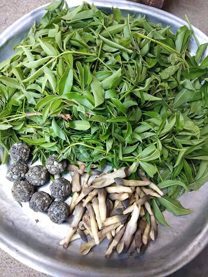
Tu-koruk, jong and wogla (Source: Daniel Apuubiik)
Tuik (Pl. tuisa, Adansonia digitata), Dried leaves (tu-korta) of the baobab tree are frequently used as ingredients for soup. Similar to wokta, the finely chopped and dried leaves of the baobab tree, which is also common in residential areas, are stored for the dry season. Bulsa women living in Europe sometimes carry a small amount of the leaves in their luggage when travelling back to Europe to prepare African dishes here.
3.2.3 More wild plants
Kaam: At the end of July or beginning of August, Bulsa women collect straw from the freshly harvested naara (early millet), pile it up near the homestead and set it on fire. The ash (katuak) is carefully collected and stored in a clay pot. When needed, this ash is used as a filter between two clay pots to make the soup ingredient kaam. The upper cheng pot of the kaam-soluk, which has a hole in its bottom, is filled with millet ash. Clear water seeps through the ash so that it has taken on a bitter taste by the time it reaches the lower clay pot (kaam-cheng). The filtering process can be repeated without changing the ash until the water in the lower pot no longer exhibits a distinctly bitter taste. Liquid kaam, also called “vinegar” by English-speaking Bulsa, is not only a popular, flavour-enhancing ingredient in most soups but is also believed to have medicinal qualities. Thus, pregnant women are advised to eat only soups with kaam water. Liquid kaam is meant to be consumed fresh. If it is to be used later or sold on the market, the liquid is completely evaporated in a bimbili pot on the fire until a white to light grey powder remains as a residue. This powder is mixed with powdered tobacco and consumed in small portions as the stimulant sarik (see p. 30).
The preparation of kaam is not the work of specialists but belongs to the seasonal routine of the housewife.
There seem to be conflicting opinions about the effects of the kaam ingredient on the well-being of a person, and it is considered especially harsh on European stomachs. Before my first sojourns in a Bulsa homestead, I was advised by Europeans and educated Bulsa to eat all warm native food without concern but to avoid katuak soups at all cost. However, I frequently consumed these soups with millet porridge without feeling any immediate positive or negative effects on the stomach. I attribute the fact that my nervous stomach ailment of several years had completely disappeared after my stay in a local homestead to the less hectic lifestyle in a Bulsa family.
Bulsa women in Europe who do not want to do without kaam when making sauces sometimes use potash, which can be bought in European supermarkets, as a substitute.
Besides kaam, which is made from the ashes of burnt millet stalks, there is tampoi kaam, which uses the ashes of the tampoi (ash-heap). The kaam obtained in this way is not used for food, however, but only for the production of gunpowder (kambon-tiim).
Local Maggi: This spice, consisting of a white powder, is very popular among the Bulsa, especially for sauces, rice, and bean dishes. It is probably produced in factories in southern Ghana since it appears no one in Bulsaland can produce it.
Salt (yesa): The often reddish-brown rock salt can (or could?) be bought at any market. The large solid chunks still have to be crushed with a stone, for example, before use.
Others: The cooks can also buy some other sauce ingredients at the local market, for example, the small, dried saltwater fish (biila) imported from southern Ghana or stock cubes imported from Europe.
3.3 Shea butter (kpaam)
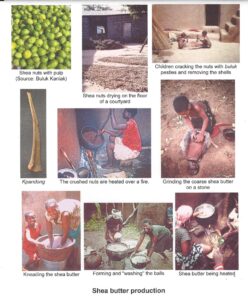
Because of their nuts, shea trees (chansa, sing. cham) are considered by the Bulsa to be the most important wild trees for their food supply [endnote 3]. They are spared as much as possible during wood-burning and lumbering despite their hard and tough wood. However, it is a strict taboo to deliberately plant shea butter trees near homesteads as is often done, for example, with mango and pawpaw trees which are not native to the area.
The shea nuts (jigsa, sing. jigsidi) ripen in June (?), but the flesh is sometimes eaten by children earlier, although it is in a hard, unripe state. The actual harvest takes place in the months from July to August (?). The processing of the nuts into shea butter can be observed at almost any time of the year as the nuts can be stored in sacks or baskets for a year or more without much loss in quality. A peak in processing seems to occur from August to October [endnote 4].
Women bring the ripe nuts home in baskets from the bush or from shea nut trees close to the homestead. The sweet, tasty pulp is available to all inhabitants of a homestead and is also offered to visitors. It is taken for granted that the nuts remain the property of the provider. Even if guests are given nuts with pulp to eat on their way home, it is expected that the fleshless nuts will be placed clearly on the footpath so that they can be picked up later. Most of the time, they collect too many nut in the bush for all their pulps to be consumed. In this case, the flesh is then fed to sheep, cows, goats, rabbits or donkeys. If the pulp is still too hard to be easily detached from the nuts, the whole fruits are buried in the ground in order to start a rotting process. After 3-4 days, they are mixed with sand and “stomped” with one’s feet so that the kernels loosen. If one wants to preserve the flesh for consumption, the fruits are only covered with leaves for a few days until the flesh has softened.
The nuts are opened with a stone, e.g. a round or angular tintankori grating stone, with the wooden buluk pestle or with the feet on the smooth, hard floor of the courtyard. The parts of the courtyard covered with shard mosaics or plastered with a cement screed are best for this. The nuts, including the kernels which often break as soon as they are shelled, are crushed into pieces in a small mortar in the courtyard. They are roasted without any other ingredients in a large aluminium pot or an earthenware vessel on the open-hearth fire. A rib of the Borassus palm (kpingkparuk) is used as a stirring stick exclusively for this activity [endnote 5]. Later, usually on another day, the nuts are pounded into a thick paste in which there are still hard pieces of nuts. This is carried out in the large mortar in front of the homestead or, as is customary in Anyenangdu Yeri, in the rock mortars. The viscous state of the nuts is achieved by released oil and not by liquid additives. The shea butter producer pours the paste into a bucket or chari clay bowl using a small calabash bowl. She scrapes the mortar and pestle clean with a shell (kanbieng), and then washes it out with water or, if available, with the reddish kpa-bi-nyiam liquid (see below). A sie brush also serves well for this purpose.
The crude shea butter is now taken to another place of work, usually in front of the homestead. The final step in shea butter making takes place in a freshly dug hole in the ground, about 20-30 cm deep, with two granite rubbing stones on the hole’s opposite sides. If the bottom of the hole is damp, a small straw fire is lit in the hole to dry it. The hole is always lined with clean sand. Often two women work simultaneously in counter-rhythm on the two rubbing stones facing each other, but completely arrhythmic work was also observed when an older woman, a visitor to the homestead, helped her young daughter. Sometimes a hole can be re-used if shea butter was made in it just a few days previously.
Only one woman is the owner of all the processed shea nuts and their products. The other women (with the exception of an older daughter) lend her a helping hand which is reciprocated by her help on a suitable occasion.
The women kneel in front of the hole, take shea butter paste from the larger vessel with a calabash bowl, pour some of it onto the lower large rubbing stone (niri, nuri), place the smaller upper stone [endnote 6] on top and begin to grind the coarse paste into a fine, thick mass which they allow to flow into the hole in the ground. It is then ladled into a clean chari bowl which is placed on a bucket to make it easier to work with. Standing up, the woman now processes the brown shea butter paste. The following operations are distinguished:
1) Damuka (mixing, blending): The woman mixes and kneads the paste with her right hand. Here, as in the two following work phases, she often adds clear water.
2) Naka (beating): She now dips both slightly curved hands simultaneously into the paste at the front of the bowl and pushes them towards the lower rear part of the bowl. During this movement she presses her hands together. This sequence of movements is repeated quickly without interruptions until fatigue sets in. Often a small break from work also begins with the sentence “N jiak kama” (I am exhausted). The naka activity facilitates thorough mixing of the paste with the water.
3) Luuntika [endnote 7]: Even during the naka phase, some luuntika movements can be incorporated occasionally. The hands dip almost vertically from top to bottom into the paste and produce a muffled sound which is probably caused by the air introduced into the woman’s hollow hand. Luuntika is supposed to separate water and fat from each other again.
4) Suurika (washing, cleaning) and ngmiaka (wringing, squeezing):
After the mass has been kneaded and beaten for about 45 minutes (phases 1-3), it takes on a light colour due to the coagulation of the fat. The actual shea butter (kpaam) has emerged and has separated from the brown-red water (kpa-bi-nyiam) on which it floats.
The producer transfers the butter into another chari bowl with clear water. The kpa-bi-nyiam liquid may be kept for later use, when for example, it is used to harden the plaster of mud walls. The butter is now purified by stirring, and the sand that still sticks to it falls to the bottom of the vessel. After another transfer into a chari with clear water, the woman forms lumps from the butter which she then literally washes and squeezes out. While the brown paste is usually scraped off the utensils and vessels with a shell, a flat pod of the danleerik tree is used, at least in Wiaga-Badomsa, for the finished butter.
With the white shea butter, the woman moves into her courtyard or kitchen, lights a fire in her daaning cooker and places a large aluminium pot (rarely an earthenware pot nowadays) containing the fat on it. After about half of it has melted, the shea butter, now darkened again, is stirred with a sapiri stir stick [endnote 8].
After this work, a threefold division of the newly-obtained purified shea butter can take place:
1) The foamy top layer is skimmed off with a mussel shell. In the past it could be mixed with kapok wool and burnt in oil lamps.
2) The actual oil is poured into calabash bowls, smaller aluminium pots or clay vessels (chengsa, bimbila, samoansa) and left to cool. By the next morning, it has turned into a whitish butter.
3) A dark brown residue has settled to the bottom of the pot of hot fat. Called kpa-binta (literally “excrement of the shea butter”) or kpa-buta (sing. kpa-buk). This fat is considered inferior because it still contains foreign substances. Early millet cobs can be rubbed with kpa-binta before roasting over the fire. Shepherd boys sometimes roast the afterbirth of a cow with the help of kpa-binta fat.
Before the shea butter produced after the first harvest may be consumed, some of it must be sacrificed to the house shrines in some Bulsa sections. In Sandema, these sacrifices take place together with the yam sacrifices (see above). Neighbours also attend these sacrifices and are offered yams with oil on this occasion. Sacrifices of shea butter without yam slices are also documented in Fumbisi. There it is believed that someone who eats yam butter before these sacrifices will get diarrhoea or be bitten by a snake. In Wiaga, as far as I know, such sacrifices are not common.
Shea butter is not only an ingredient for sauces but also an addition to yams, bean dishes, frafra potatoes, etc. Kpaata, the third day of the kumsa funerary celebrations, is named after shea butter. On this day beans (tue) and round beans (suma) are prepared and eaten with a lot of fat (kpaam). Women of the homestead make fresh shea butter on the morning of this day (see www.Buluk.de/new for descriptions of funerals in German).
Shea butter is not limited to a purely nutritional role. All medicines made from charred roots, bark or branches are mixed with shea butter after grinding to make the mixture softer, regardless of whether they are eaten or used as body ointments. Buildings are marked with kpaam and black ashes in the form of crosses to keep evil spirits away. The kpaam makes the ashes difficult to be washed off.
Clay vessels, wooden weapons (clubs, quivers, bows), the horns of war helmets, transverse trumpets and many other objects made of wood, horn or leather are rubbed with shea butter (mostly kpa-bi-nyiam) to give them a sheen that is regarded as beautiful. But preservation and protection against rot and pests may be the main reason.
I was told that in the past one wife rubbed her husband’s back every evening with shea butter before he went to sleep.
The shells of the nuts cannot generally be of use any further. Occasionally the fallen umbilical cord of a baby is squeezed into a single shell and inserted into a small hole inside the mud wall above the entrance to the ancestral room.
A shell or a whole nut in the soothsayer’s bag has the symbolic meaning of “without frictions, smoothness, without problems”.
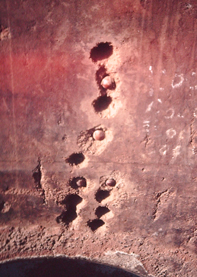
Shea nut shells with navel strings in the wall of the ancestor room
4. SMALL DISHES
4.1 Kaponta and kooko
Popular dishes at breakfast time are kaponta and kooko (Hausa loanwords). The two thick millet dishes differ in that kaponta is fermented whereas kooko is not.
Kaponta is an intermediate product of saab production. After fermented millet water is brought to a boil on a three-stone cooker, most of the millet flour needed is mixed with it to form a thick paste which is then stirred into boiling water where it continues to boil for some time. This intermediate product is called kaponta. Every morning, kaponta is offered for sale at or near most markets where women buy it for breakfast even though they can prepare it themselves. In the past, kaponta and kooko were probably eaten without ingredients, but today most people sprinkle some sugar into it and eat it together with maasa, koosa or bread.
Lunch may consist of dishes similar to breakfast or the smaller dishes listed below, but today women also cook their own hot dishes or reheat a leftover dinner from the previous day.
4.2 Pumpkin (peri, Cucurbita sp.)
Pumpkin plants look almost like calabash plants in the field, but they flower yellow (calabash: plants white) and their leaves are harder and rougher.
Using 3-4 seeds to a seed hole, they are planted at the same time as millet and are usually located in or at the edges of millet fields and are harvested just before or after the late millet harvest (za-piela or za-monta).
In the early stages pumpkins are weeded along with the main crop on the same field, but when the plant has grown larger, it is difficult to weed and there is the risk of chopping off some of the stalks in the process.
To eat them, a woman peels the pumpkins, cuts them into pieces and boils them in a pot without water since the fruits themselves contain enough liquid. When the pumpkin water boils, she adds a paste of mashed groundnuts and pepper to taste but never salt.
The pumpkin dish is often cooked in the evening and eaten the next morning. Since one tends to get hungry again quickly afterwards, it is not a substitute for a warm millet, maize or rice dish but rather a tasty snack between warm meals.
4.3 Legumes
VARIETIES
| Buli name | English name | Description |
| Tue | (small) beans | general name for all beans except suma |
| Tu–pieluk | completely white, planted later and less common than tu-sobluk; rarely grown in monoculture. | |
| Tu-sobluk | dark blue, spotted, sown in see-holes about three weeks after sowing naara; harvested quickly after maturity, as otherwise beans are pecked up by guinea fowls. | |
| Suma | Round beans | sown in groundnut fields after heavy rain, e.g. early July, but not in the same seed-hole as groundnuts; one bean per hole |
| Sum-moaning | red round beans | harvested in early October before sum-pieluk and sum-buuk. |
| Sum-pieluk | white round bean | white variety |
| Sum-buuk | harvested last | |
| Soalimpiak | black geocarpa bean or Hausa groundnut | not very common in Buluk; grown on raised beds; can, according to a taboo, only be grown for three years on one bed |
| Sain-tiim | Imported from Northern Region | |
| soy beans | introduced after 1989 | |
| Kantibsa: | “bush bean” | bitter beanlike fruit; unripe: green, ripe: dark blue |
| cow peas; Vigna unguiculata, | black |
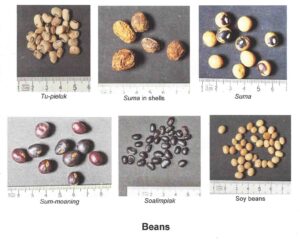
As ingredients in sauces beans (tue and suma) are not only used in mashed form but also with shea butter and pepper as individual dishes, as a side dish or a snack with yams and other tuberous fruits or with boiled or baked plantains.
Tue (sing. turi)
These beans are much smaller than those common in Europe and only slightly larger than a grain of wheat.
Round beans (suma)
Suma, prepared with salt and oil, in a soup or separately, can be eaten at any time and can also replace a full meal (millet porridge or rice). Some working Bulsa buy rice with round beans at the market before work.
In contrast to a mixture of round beans and (small) beans (tue), round beans and wiiga (seeds of Hibiscus sabdariffa) may be cooked in the same pot during meal preparations. Usually wiiga are pre-cooked, then round beans are treated in a small mortar to light pounding (according to other information, only the shells are removed) and cooked together with the half-cooked wiiga seeds. Salt and millet flour are stirred in. The dish is usually eaten with salt, pepper and shea butter (J.Ag.).
A bean dish consisting of a mixture of tue and suma beans is usually strictly taboo, although it is prepared on the third day (kpaata dai) of the Kumsa funeral celebrations with lots of shea butter but without any spices or salt at all. For this, the round beans, whose cooking time is longer, have to be pre-cooked and the tue beans are added later.

Bean-food is “sacrificed” to a wall on kpaata-dai
Kantibsa
This plant, about 30 cm high, grows wild in the bush. The bean-like fruits have to be cooked three times in oil, but nevertheless they still taste bitter. Only pepper is added as a spice, but no salt.
4.4 Maize (cholimbein, Pl. cholimbena, Zea mays)
VARIETIES OF MAIZE
| Golden Crystal | yellow; wind pollination results in hybrid forms, i.e. Laposta and Golden Crystal on the same cob |
| Laposta | pale, larger and heavier cobs than Golden Crystal, grains are dented at the top. |
| IR 30 | a variety introduced from Europe, large, white corn |
Maize, originally cultivated in North America, has enjoyed growing popularity among the Bulsa in recent decades.
After harvesting the cobs, they are dried in the hot sun and ginned by hand. Only loose grains of maize are stored in sacks or in baskets. There are many ways to eat it. Immediately after harvesting, one can roast some cobs. Both the cobs and the grains, after having been ground in the mortar, can be boiled in salt water before consummation. Grains are ground in the nika-nika mill as they are too big and hard to be ground in the nanzuk (grinding room, J.Ag.). The flour is used for kenkey, banku, kooko and saab. As a soup ingredient, the grains are pounded into meal in a mortar but not ground and can be combined with tuita, kazaksa or wokta sauce.
Women use the empty cobs to make decorative patterns in the freshly plastered walls of their courtyard and even outer walls.
Ritually, maize plays no role. A maize-millet porridge is not allowed for sacrifices or ritual meals at funerals. Probably in almost every diviner’s bag one finds a small, empty maize cob with the symbolic meaning ngandiinta (food). I suspect that the maize cob has substituted a millet cob, because the latter is more easily damaged among the heavy metal or ceramic symbolic objects in the diviner’s bag.
4.5 “Cakes” and similar dishes

Maasa-chengsa with six and four troughs after firing
Maasa millet cake
Almost every major Bulsa market has some women who bake millet cakes (maasa) on the spot for visitors. They make a liquid dough from millet flour, water and salt, heat some shea butter on a ceramic baking plate (maasa-cheng, see Kröger 2001: 203-204) over the open fire of a three-stone hearth and ladle equal portions of dough into the 4-12 troughs of the plate.
After a father’s or mother’s visit to the market, their children often expect them to bring home some maasa for them.
Kamsa bean cakes
Bean cakes can be baked similarly to maasa on a baking plate. The dough is made like this: Cowpeas or round beans (suma), tue beans and, if available, also bumbota tubers are cooked with some added spices (salt, pepper?) and then pounded together in a small mortar and fried on a baking plate.
Like the dish consisting of tue beans, suma and kpaam, a women can also offer kamsa to the outer wall of the homestead next to the entrance pillars (zamongue) on the 4th day of the kumsa funeral celebration. Even though this is not a real sacrifice (which are only performed by men), this process is called parik kaabka, “offering the wall”.
Koosa (sing. koosiri, loanword Hausa)
The preparation of koosa cakes is somewhat more tedious and complex. According to one informant, the housewife soaks beans, together with other types of beans and bumbota in water for 1-2 days until the skin loosens. In the past the white bean seeds were dried for at least one day and then ground in the grinding room (nanzuk), today they are “ground at the nika nika grinding mill without soaking them before, because koosa need smooth flour” (J.Ag.). The flour is mixed with water, salt, pepper and/or ginger (kaaka-duruk). For this purpose, the dough is beaten with both hands in a chari bowl, similarly to what was described for making shea butter (naka, also luuntika?). It was explained to me that this processing, during which the dough probably also absorbs air bubbles and increases in volume, eliminates the need for a leavening agent. In a modern metal pan or, in the traditional way, in a chari bowl, the woman heats shea butter until it boils. With a calabash ladle, she pours constant quantities of the dough into the oil. These cook there until they have taken on a yellow colour. Koosa bean cakes are also sold at the market.
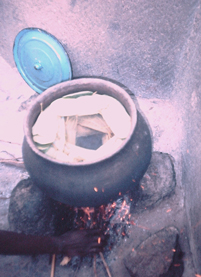
Preparing pobla
Pobla
The third type of bean cake is probably the most popular, and the supply of this dark, green, shiny “cake” is probably not missing in any market. Besides the Buli names pobla (sing. pobli) and tubaani, one also hears the names couscous [endnote 9], bean kenkey and bean cake.
In the past the beans (tue) were ground on the millstones of the grinding chamber (nanzuk), in recent times they are ground only at the nika nika (J.Ag.). Then they are mixed with water, salt, shea butter, pepper and kaam. The latter is said to have the effect of a leavening agent here.
Further processing can take place in two different ways.
1. The bean dough is smeared on the inside of a bimbili pot, and a second bimbili is put on the fire with some water. To prevent the boiling water from splashing up, leaves, stalks or similar things are put on top of the water. The bimbili pot with the bean dough is now placed upside down on the pot with boiling water (i.e. opening to opening) so that the dough is cooked only by the hot steam rising up.
2. The dough can also be placed in measured quantities on the heart-shaped leaves [endnote 10] of the busum-boong tree (Piliostigma thonningii). On the surface of the boiling water, the preparer places small sticks onto which leaves holding the bean paste are placed. She covers the pot with another clay pot or lid so that the cakes are steamed again.
Fuura, funfuura
Millet grains are coarsely crushed by pounding and then set to ferment before being cooked with pepper, ginger and other spices. At the market, fuura is sold in small balls and mixed at home with milk and, nowadays, also with sugar. It is enjoyed as a refreshing drink.
5. STIMULANTS
5.1 Tobacco (taba, Nicotina tabacum)
Tobacco is grown in beds close to the homestead wall, usually only in small quantities for personal use. The dried leaves can be smoked in a traditional clay pipe (tacheng), in hand-rolled cigarettes often with a page from a newspaper or old exercise books serving as “cigarette papers”. They may also be ingredients for another stimulant called sarik (see below).
Tobacco is offered on the market by Bulsa traders or strangers by the piece in stick or ring form (ø 10-20 cm), by the spoon in crumbled form or in small bags. In the past, tobacco leaves were also cut into coarse strips on a wooden board and then smoked in the pipe. In Abasitemi Yeri (Badomsa), Ayomo, the head of the homestead, demonstrated this to me using a 43 cm long pipe that his father’s mother had bought for 20 pesewas in Navrongo and was smoked afterwards by the woman. Ayomo smokes this pipe occasionally, but, as he told me, this is very difficult because the smoker has to “draw” in the smoke very intensively.
A pipe stem is always made of tangmaaruk wood (= taduok) and the bowl of fired clay (see Kröger 2001: 233-35 and photo 41).
5.2 Sarik
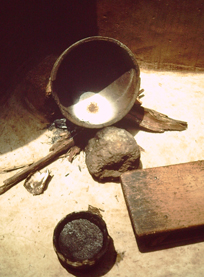
White sarik residue after vaporizing the liquid parts of kaam
Sarik is a stimulant consisting of tobacco, shea butter and kaam. All three ingredients are pounded and crushed in a sarik mortar (sarik tuik), the dimensions of which are considerably smaller than those of the small mortar used for soup spices (height of sarik-tuik in Akanming Yeri: 19.5 cm).
Since men as well as women can be sarik consumers, either may be the producer of sarik, as I was able to observe myself in Akanming Yeri (see Kröger 2001: 374-75).
5.3 Hashish (Cannabis sativa, Buli: wii or ta-pagrik)
Cultivation, distribution and acquisition of this drug is illegal in Ghana. Nevertheless, it has been cultivated in small quantities for personal use in some Bulsa homesteads. The Bulsa attitude towards the consumption of this drug seems to be very ambivalent. When my informant, the now deceased teacher Leander Amoak, learnt that a group of his field workers had been smoking hashish while working, he confronted the responsible distributor with vociferous accusations. Other fathers do not object to their sons smoking hashish. In one homestead where hashish was grown in small quantities, an unmarried daughter of the landlord, suspected of contacting spirits at night, told the men that the earth shrine (tanggbain) of the homestead did not like hashish being smoked. After that, cultivation and consumption stopped quite abruptly.
The practice of adding powdered hashish to the finished millet beer (daam) without the knowledge of the customers, is said to be common with some women producers in Navrongo, Bolgatanga and also in Sandema.
5.4 Kola nuts (Cola nitida, goora, sing. goori)
Large quantities of Kola nuts are imported into northern Ghana by traders from their growing areas in southern Ghana, especially from the Ashanti rainforest. In Bulsaland there are local traders who have become quite prosperous through the kola trade.
In some sections, e.g. Sandema-Kalijiisa, the number of kola traders is particularly large as certain knowledge about market situations, profit opportunities, contacts, etc. is passed on, mainly among one’s own kin. Kola nut sellers are not only to be found at every market, no matter how small, but they also have a stall in the centre of the villages outside market days. The nuts are sold by the piece. On a wet cloth, the seller has set up small heaps of 2-5 kola nuts. These heaps are then divided, for examples, into two or three price groups. The customer chooses one or more heaps and can always expect a bonus (jaara) of 1-2 nuts.
If the buyer does not want to consume the nuts immediately, he must always keep them moist, e.g. in a damp sackcloth, in the kpachari chicken trough or in a water storage vessel (liik). For some Bulsa, eating kola nuts has become a constant habit. Old people with gaps in their teeth rub the nuts before eating them. For this purpose, a flat tin can, e.g. a sardine tin, is converted into a grater by punching many holes into it with a hammer and nail.
As in other parts of Ghana, the Bulsa use kola nuts, because of their caffeine content, to ward off fatigue, and they are often used by, for example, car drivers when driving at night.
The importance of kola nuts in the social and ritual sphere of Bulsa life is very great. They are the most common present given by a visitor to a foreign homestead and also play a major role in courtship and preparatory visits before large ritual celebrations. They are not handed over at the first contact between guest and host, as would be customary in Europe, but after the ritual greeting and after the visitor knows that his request will be kindly received. The host’s counter-gift, e.g. a few eggs or a chicken, is only handed over when the guest is about to leave. Once I gave away kola nuts in Sandema-Bilinsa before formulating my request, in which I asked for some information on ancestor worship. However, they were not ready to answer my questions, and they gave me back my kola nuts during the thoroughly cordial farewell. On the other hand, it is always emphasised that the gifts for the host are not meant to be payment for the fulfilment of a request. This assertion is supported by the fact that, after lengthy interviews, which were hardly compensated financially with the kola nuts, I was given a chicken as a farewell gift, the financial value of which far exceeded that of the nuts.
Kola nuts do not play a major role in the traditional religious sphere. I only saw kola nuts being sacrificed once, by a Bulsa diviner in Gbedema-Balerinsa, who was divining with the help of talking bush spirits (kikerisa). Before consulting his spirits, he asked me for akpeteshi (palm brandy) and kola nuts as offerings for his divination shrine. This consisted – also unusual for Bulsa – of an upturned calabash bowl. He poured some brandy over it, chewed a kola nut and spat the contents of his mouth onto the shrine. This diviner, however, had lived in the Ashanti region for a long time, and this may explain the forms of sacrifice that differed from Bulsa rituals.
Some kola nuts and a 1000 cedi note, found by the earth priest Anamogsi (Badomsa) on his tanggbain in 1996, caused concern. Here, it was believed that through these gifts, the giver wanted the tanggbain to harm somebody. Afelik, the earth priest of Wiaga-Longsa, also found a white kola nut on his tanggbain one day. He did not know whether this had been placed there by a good or bad person. He told the earth shrine that he would agree to any response (possibly a punishment) to befall the giver.
Kola nuts have a greater ritual significance among Muslim diviners (maalams) who divine by means of the geomantic or sand method. In Bulsaland, they are often Kantussi (Yarsé) living mainly in Fumbisi and Sandema. Non-Islamic Bulsa also consult them, often following a visit to the traditional Bulsa diviner to check his results. As Muslims, they are not allowed to prescribe offerings to Bulsa shrines (bogluta), but often they order the client to place some kola nuts, a coin or root medicine on a mound of gusung-guuri ants.
This offering is referred to by the Bulsa not as a sacrifice (kaabka) but named by the Hausa word sarika.
According to Irvine (1961: 170), Muslims consider the kola nut sacred because it was brought to the people by the Prophet.
6. Alcoholic beverages
6.1 Sorghum beer (pito, daam)
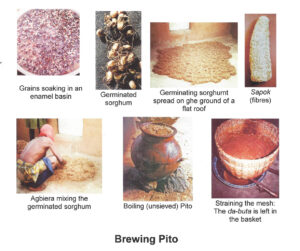
The process of brewing sorghum beer has already been described in a small, unpublished paper by Margaret Lariba Arnheim from Gbedema (Münster 1988, footnotes by R. Schott) and in Martin Striewisch’s unpublished master’s thesis (Münster 1988), which, at least regarding the Bulsa, also partly refers to information obtained orally from M.L. Arnheim. Since both works are currently difficult to access, the most important phases of the production process will be pointed out again, especially so since the process I observed several times in Anyenangdu Yeri with the older women Agbiera and Achioklie differs in some practices from those described by Arnheim and Striewisch.
In principle, all varieties of millet (early millet naara, late millet za-piela and almost all varieties of sorghum) and even maize can be used for brewing, but in practice almost only red sorghum (za-monta) is used; naara and za-piela are very rare. The brewer is always a woman. Although there are many female experts, almost all Bulsa women and sometimes even schoolgirls are able to brew beer. The work always takes place in the brewer’s courtyard. In a few Bulsa homesteads where highly specialised women brewers live, there is a separate brewhouse (daam-dika-dok), which is mainly used for boiling the mash. These are either roofless round buildings, similar to fair-weather kitchens, or they have a thatched roof and their side walls are open, similar to the kusung “to allow the intense heat generated to escape easily” (J.Ag.).
6.1.1 Malting
In the malting process the threshed millet grains are soaked (lusi) in a large chari clay pot, “in recent times large aluminium basins are also used” (J.Ag.) for about a day [endnote 11]. Then the woman spreads the grains over an area of usually 1-2 square metres in a layer about 5 cm thick in either a clean corner of her courtyard or on the flat roof. In the view of the Bulsa, a good hand (ni-nalung) is also needed for this preparation of germination (wuuka) because the millet does not germinate for a small proportion of women [endnote 12]. The brewer turns the millet with her hands at least twice a day, sprinkles it with water (e.g. a quarter of a bucket) and she untangles it after germination has occurred. The millet is always covered. Agbiera from Anyenangdu Yeri puts a thick layer of green millet leaves over the grains and bundles of millet leaves tied together as a border around the spread millet and covers everything with a kpasik mat. Achioklie, also from Anyenangdu Yeri, uses a plastic sheet for this purpose.
Once the first germs have sprouted, a special treatment can take place. Agbiera treats the germinated millet (millet malt, kpaam or kpaama) with kaam (see above). She moistens her hands several times with this liquid and mixes the millet in her hands each time. Then she stores the malt in a dark room for two days and dries it on a flat roof, six days in the case of the observed brewing process of Agbiera. I also observed Agbiera constantly tasting the boiled malt during her work. “Experienced brewers or malt makers know the taste of good quality malt” (J. Ag.).
6.1.2 Grinding (numka) and mashing (pusika)
The brewer grinds the millet malt in her grinding room or has it ground at the nika nika into flour that should not be to fine or too coarse. and then mixes it with water in a large clay pot, most likely a daam-kabook (others?). The mixing ratio of malt and water, which is usually at the discretion of each brewer (J.Ag.), is crucial for the future strength of the beer. The malt is left in the kitchen for at least 24 hours. Before boiling (dika), various ingredients which probably have an influence on the brewing process or change the taste of the millet beer can be added to the mash. In other ethnic groups this can be a fibre from a tree bark (Konkomba, Langdon n.d.: 201) or the crushed stems of Hibiscus esculentus (okro), leaves of the baobab tree, fruit of Balanites aegyptiaca or the seeds of Datura stamonium. Among the Bulsa, I saw Agbiera (Anyenangdu Yeri) pound the bark of a thick okro stem on a stone and add it to the malt before sieving. Some Bulsa women add crushed pusik fruit to the boiling broth. All this is said to influence the taste of the millet beer.
6.1.3 Boiling (dika)
In a large daam-samoaning (ceramic pot), the intermediate product is brought to a boil on a three-stone hearth fire, which causes the starches of the malt to turn into sugar. All informants stress that a constant and even supply of fuel is important. Otherwise the beer does not reach optimal quality and may be too weak. Agbiera therefore mainly uses cow manure as fuel, as there are many cows in the compound. Other brewers use logs of woods (J.Ag.).
After a few hours of boiling, the mash is poured into big samoansa (pl.). to cool and to be strained thereafter. A traditional calabash sieve with larger holes than the one used for sieving millet flour, a tin sieve or a fly wire can be used for the sieving process (chagsika). The residue remaining in the sieve is called da-buta in Buli and is usually not eaten by adult humans but fed to chickens, ducks, rabbits and pigs or thrown away as waste. The sieved mash is cooked again for a few hours. The exact cooking time is left up to the woman and could not be determined exactly. During the boiling, foam constantly develops which the brewer skims off with a grass brush held like a fan (daam-sie) and mixes with the da-buta. After the second boiling, the mash is cooled in a large chandong bowl or, if this is not available, in a chari.
6.1.4 Fermentation (kumka)
For fermentation the mash is transferred into a big pot (e.g. a liik). If it is a very old pot, it is usually not necessary to add da-binta, which is used as yeast. As in other ethnic groups, fibres are added to accelerate fermentation [endnote 14]. In the case of the Bulsa, it is often the fibrous skeleton of a fruit called saapok (Luffa aegyptiaca? Cucurbitaceae) [endnote 15]. If the same saapok has already been used in an earlier brewing process, there is also no need to add yeast.
By the next morning, the fermentation has progressed so far that an alcoholic beer called da-paalik (new beer) has emerged. The still-ongoing fermentation can be recognised by the bubbling movement of the cloudy liquid. People with a sensitive stomach are advised not to drink the “new beer” as it can easily cause diarrhoea. After complete fermentation, the beer is called da-nubi (literally: female beer) or da-kum. English-speaking Bulsa, but also other inhabitants of northern Ghana, call it “black beer” because of its clearer, darker appearance.
The finished beer must be consumed within three days, after which it becomes undrinkable.
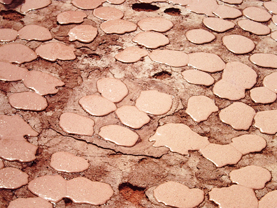
Da-buta drying in the sun to become yeast
6.1.5 The production of yeast (da-binta, sing. da-bing)
In the clay pots of the fully fermented millet beer, e.g. on the bottom of the daam-samoaning vessels from which the beer is sold in the market, leftover yeast (called da-binta) settles (J.Ag.).
If enough of it has accumulated from several brewing processes, it is spread out in pancake-like patties on the clean and smooth floor of a courtyard to dry. After a day, cracks form and all the pieces are swept together with a grass broom. If larger quantities are made, a portion can be sold at the market. One Bulsa family in Bolgatanga has specialised in the production of this yeast as they have a large courtyard (although the family itself does not brew beer). Rather, they get the marc for free or for little money from the brewers.
As far as I know, no professional full-time brewery has yet developed in Bulsaland.
6.1.6 Unfermented millet beer (da-bein, literally: unripe beer)
The brewing process can be stopped after the second boiling if one wants a non-alcoholic “beer”, and sometimes only part of the boiled mash is left to ferment.
“In Sandema, any daam that has not been fermented or has not yet started fermentation is called da-bein. It keeps longer and the brewers/sellers typically keep this one aside to add to the fermented beer when it is becoming harsh so as to make it drinkable again. These days, many sellers also sell the da-bein separately or a buyer can ask for a mix of the fermented and the unfermented one” (J.Ag.).
Further advantages for the unfermented beer are obvious: larger quantities of a healthy and thirst-quenching drink can be enjoyed without negative after-effects for adults and especially children. Unfermented beer can be ritually offered in the same way as alcoholic beer, according to special instructions from the diviner (baano). It is usually associated with children not so much because it is drunk by children but because it is immature (bein) just like children.
At a wen-piirika celebration in Asik Yeri, for example, only unfermented pito was offered as it was supposed to symbolise the immaturity of the still very young boy who was given his first personal shrine here. A large clay pot of fermented beer was given to the diviner as the officiant of the ritual.
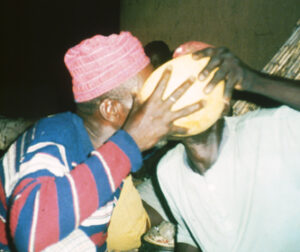
Two friends drinking from one calabash
6.1.7 Drinking customs and the use of pito in secular life
The transport, sale and distribution of pito is, like the whole brewing process, a woman’s business. She always keeps the beer in large clay jars from which she later pours it into the calabash drinking bowls with a calabash ladle. When a guest is offered a calabash of pito (or food in general), he says “N’be chogsi” [endnote 16]). After drinking or eating, the receiver can say jiam-jiam.
When two good friends want to demonstrate their friendship, they drink from one calabash at the same time (Ba kpabi ka daam, see photo). This custom, too, has become rare in recent times.
At the market, the pito stalls are usually located on the outskirts of the market-square proper and on the access roads. The saleswoman first offers her customers half a bowl of the drink free of charge to try. However, the customer has to endure a torrent of harsh words if he leaves the pito stand without buying a bowl of millet beer.
Usually nothing is eaten with the pito. However, I did observe some men sprinkling a brown powder on their beer. It was musiri medicine, which is supposed to protect them against diarrhoea as well as hernia.
Some women brewers also offer pito in their homesteads outside market hours, especially if they have not sold the entire production quantity at the market.
6.1.8 Pito sacrifice
Larger animal sacrifices usually require a subsequent millet beer sacrifice with which the “animal blood is washed off (suuri) from the sacrificial shrines”. The preparation of this sacrificial potion differs from that of ordinary beer. The most senior woman of the homestead is almost always responsible for the brewing process, but she can ask for help from all the other women. The sacrificed pito is almost always made of za-monta (sorghum). Only a mungo shrine (juik-bogluk) can request early millet beer (naara-daam) through the diviner. In any case, the millet must have been harvested from the doning, the landlord’s field in front of the homestead, and all preparations should take place at the homestead itself. Buying millet malt on the market is not permitted in this case. All important potential guests are notified of the mash being put on the cooker as this also sets the date of the sacrificial celebration. In the case of large upcoming festivals, three shots from a “buried cannon” (da-goong, iron tubes filled with gunpowder) are let off to inform the neighbours that the mash has been placed on the fire. For chickens and goats (?), this may be done on the same day, and for sheep and cattle a new date is set.
The pito sacrifice (kpaantuok), which takes place after the harvest sacrifices (fiok-bogluta) each year and are made to all the shrines of a homestead, are not regarded as independent first-offerings, according to some informants. Rather, they are considered supplements or the final part of the fiok animal sacrifices, i.e. here, too, the pito is supposed to wash the sacrificial blood off the shrines. However, those shrines which did not receive a blood sacrifice before are included in this ritual.
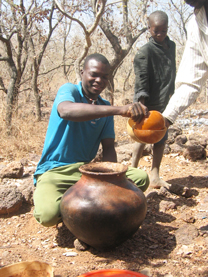
Sacrificing daam to a tanggbain
6.2 Akpeteshie (distilled palm wine)
Akpeteshie is a drink produced in southern Ghana by distilling the sap of the raffia palm or sugar cane. However, the Bulsa have also attempted to distill palm wine.
Today, Bulsa can buy akpeteshie by the bottle or the drum not only at every market and beer stall, but also in many traditional homesteads where at least one person has taken up the sale as a source of extra income.
In recent years, there have been strong efforts to restrict the consumption of this drink. For example, the Sandemnaab Azaksuk Azantilow has banned the sale of this drink in homesteads altogether, and there are repeated futile calls to ban its consumption at major funeral ceremonies.
Before a donor distributes akpeteshie to those present, he pours a few drops on the ground as libation to the ancestors without expressing any prayers or wishes.
“It is understood by all who would participate in the drinking that the drink is ‘safe’ to drink, i.e., the one offering has not poisoned it” (J.Ag.).
Akpeteshie is never used for formal sacrifices.
6.3 Bottled beer
Bottled beer has found wide acceptance, not only among educated Bulsa but also among inhabitants of traditional compounds and other (male and female) people of all classes and positions. In terms of price, it is more expensive than millet beer, but it has some advantages: It can be purchased at any time in a pub or stall, and the unopened bottle can be stored for a long time. Unlike pito, people like to drink it chilled and it is therefore kept in a water pot (for example liik) if it is not consumed immediately.
It cannot be used for sacrificial purposes. However, sometimes a bottle of beer is placed in the ancestral room (dalong) of a deceased person whose funeral ceremony has not yet been held and who was a beer drinker during his lifetime. It is meant for his soul (chiik), which stays in or near his death mat.
7. TREE FRUITS: PAWPAW, MANGO AND OTHERS
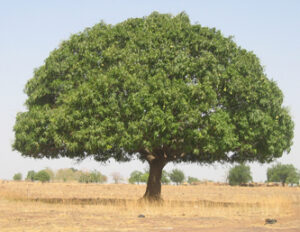
Mango tree
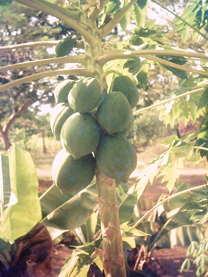
Pawpaw fruit
Of the introduced tree species, pawpaw (Carica papaya), mango (Buli mangook, Mangifera indica), bananas (koduuta, sing. koduuk, Musa sapientum) and plantains (boadie, sing. boaderi, Musa paradisica) are particularly popular. Mango and pawpaw are usually cultivated from the fruit seeds. Pawpaw trees are found quite frequently near a homestead (for example, at the outer drain of a bathhouse or even inside a homestead). Mango trees are also found, often in groups, near homesteads. Although they have a specific owner, other inhabitants of the homestead, neighbours and friends may pick a fruit or two from them for their own consumption. This arrangement may also be due to the fact that mango trees often produce more fruit than one family can consume. As far as I know, there is no permanent storage facility.
Plantains and bananas are usually grown in dry-season gardens after the owner has acquired some offshoots. After harvesting the fruit of one plant, many offshoots around the plant develop.
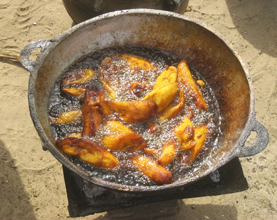
Fried plantains
The fruits of numerous other trees growing wild in the bush are used by the Bulsa. Although the still-green hard fruits (moota) of the fig tree (kingkana, sing. kingkain) are sometimes pounded by women in a mortar and used as an ingredient in soups, most wild fruits are probably eaten raw. For example, shepherd boys tending their cows in the bush will eat wild fruits to satisfy their hunger.
8. FOREIGN DISHES AND THE SURVIVAL OF TRADITIONAL DISHES
In recent years, European dishes have gained popularity among a more or less large number of Bulsa. However, they are far from displacing the local dishes.
While many European and American products (different types of cabbages, carrots, potatoes, brown bread, noodles etc.) had been largely absent from Bulsa market in the time of the author’s fieldwork (1973-2011), “this is no longer the case. These foods are now widespread in all large towns. In fact a packet of noodles can be bought even in many small village markets” (J.Ag.).
In the large garden of the Catholic mission in Wiaga, small quantities of these vegetables can be found, but part of them are probably intended for European missionaries and employees. One reason for the low attractiveness of these goods is probably the higher price. While Bulsa women will gladly accept a plastic bottle of European oil as a gift, they will rarely pay the high market price for it.

The garden of the catholic mission
ENDNOTES
Endnote 1: In my account, I follow Margaret Arnheim’s unpublished paper on saab preparation written for R. Schott in 1979. In Anyenangdu Yeri (Badomsa) I often observed my cook Agoalie from Sandema-Nyansa and Akankonurba from Siniensi, both wives of the landlord Anamogsi. Akankonurba prepared then kaponta for sale. The observation of a woman’s cooking by a man is considered very unseemly. So I thank both, but also Mrs. Arnheim and Prof. Schott for allowing me to use the manuscript for my work.
Endnote 2: The actual medicinal plants were dealt with in articles by F. Kröger in 2019: “The Medical System of the Bulsa” and “List of Plants for Medicine and other Purposes” (both in BULUK 12).
Endnote 3: According to a 1912 survey arranged by the then-British colonial government (Government of the Gold Coast: Accra, Report on the Agricultural Department 1912, p. 19; quoted from G.B. Der, Universitas, n.d., p.5) the kernels yield 52% oil. Attempts and plans for economic exploitation on a larger market scale were abandoned in 1925 after the departure of Governor Guggisberg.
Endnote 4 : My own observations of the production of shea butter took place on the following days: 20-7-1984, 4-8-1974, 14-8-1973, 20-8-1986, 11-9-1988, 25-9-1988, 9-10-1988, 9-12-1988, 9-3-1989 (funeral), and 25-4-1989. Observations of the production of shea butter by the Koma, a neighbouring ethnic group of the Bulsa, revealed an almost completely identical production method.
Endnote 5: Kpandon or kpaamdong, pl. kpandongta; kpaam = shea butter, dong occurs only in compound words and usually has the meaning of “large”; cf. chandong, large bowl.
Endnote 6: There are very many word variants for this, but they all have the same meaning and linguistic composition: nimbiik, nambiik, numbiik, nambiing…, (pl. nimbisa, nambisa…); cf. num = to grind; biik, literally “child”, often has the meaning “small” in a compound noun (as does biim).
Endnote 7: The verb luunti and its verbal noun luuntika denote only this particular activity of processing shea butter and could not be derived or found in any other context.
Endnote 8: On this occasion, some women use the boiling fat to fry a quickly-prepared cake made from the coarsely-ground flour composed of early millet and water. These oil-fried cakes are called guma (sing. gumi).
Endnote 9: Pobla bean cakes have little in common with the “couscous” of North Africa, which consists of coarsely ground, steamed cereal grains (durum wheat, barley or millet) and is the main food there.
Endnote 10: The leaves are also called pob-vaata (sing. pob-viok) because of this use. It is also possible that the bean cake got its name because of the “wrapping” (Buli: pobi). Other leaves, e.g. maize or kola, can also be used, but they must not contain any bitter substances. Otherwise, the flavour of the cakes could be impaired.
Endnote 11: According to my own observations, it is generally unusual to prepare the not-yet-cored millet husks as described by M. Striewisch.
Endnote 12: M.L. Arnheim suspects that these women are “too clean”, i.e. that an overly sterile environment has been created by the use of soap.
Endnote 13: Agbiera uses about 1/4 bucket for this each time.
Endnote 14: According to Langdon (p. 201), among the Konkomba, it is a thick, braided rope.
Endnote 15: Such a plant part is usually used as a massage sponge in the daily bath, cf. Kröger 2001: 259.
Endnote 16: The literal meaning is actually “Take!” or “Catch!”, i.e. a saying that might be more expected by the giver.
REFERENCES
Arnheim, Margaret Bawa Lariba
1979 Daam dika – The Brewing of Millet Beer. Münster [unpublished Manuscript]
Atuick, Evans
2019 Tamarind (pusa), a Neglected Resourse of Buluk’s Development, Buluk Kaniak (Facebook Group), 9 January 2019.
Chalfin, Brenda
2003 The North goes Global: Export Markets and Indigenous Commodities. In: F. Kröger and B. Meier: Ghana’s North. Research on Culture, Religion, and Politics of Societies in Transition, Frankfurt a.M., Berlin, Bern, Bruxelles, New York, Oxford, Wien.
n.d., Agricultural Policy in Northern Ghana during the Colonial Area. Universitas, an Inter-Faculty Journal (University of Ghana, Legon), vol 8: 3-18.
Fortes, M. and S.L.
1936 Food in the Domestic Economy of the Tallensi. Africa 9: 138-176.
Irvine, F.R.
1961 Woody Plants of Ghana – with Special References to Their Uses. London: Oxford University Press.
Kost, Tina-Katja and Carolin Calenius
1992 Ghanaische Frauen erzählen aus ihrem Alltag. Problemanalyse aus der Sicht von Frauen eines Dorfes in Nord-Ghana. Hamburg: Institut für Afrikakunde.
Kröger, Franz:
1978 Übergangsriten im Wandel. Kindheit, Reife und Heirat bei den Bulsa in Nord-Ghana, Kulturanthropologische Studien, eds. R. Schott and G. Wiegelmann, vol. 1, Hohenschäftlarn: Renner Verlag
—– 1986 Der Ritualkalender der Bulsa (Nordghana), Anthropos, 81, 671-681.
—– 1992 Buli-English Dictionary. With an Introduction into Buli Grammar and an Index English-Buli. Münster and Hamburg: Lit Verlag.
—– 2001 Materielle Kultur und traditionelles Handwerk bei den Bulsa (Nordghana). Forschungen zu Sprachen und Kulturen Afrikas (ed. R. Schott), 2 vols., Münster and Hamburg: Lit-Verlag.
—– 2016 Traditional Activities of Bulsa Women. BULUK, Journal of Bulsa Culture and Society, no. 9: 38-49.
—– 2019a The Medical System of the Bulsa. BULUK, Journal of Bulsa Culture and Society, no. 12: 58-88.
—- 2019b List of Plants for Medicine and Other Purposes. BULUK, Journal of Bulsa Culture and Society, no. 12: 89-107.
Langdon and Breeze
Appendix 8: Pito, p. 201, in: Konkomba-English, likaln-likpakpaln Dictionary. Tamale: Ghana Institute of Linguistics.
Meier, Barbara
1992 “A chief does not cross Ashes” – Einige Gedanken zum Aschesymbolismus in Riten und Erzählungen der Bulsa. In: W. Krawiets, L. Pospisil and S. Steinbrich (eds.), Sprache, Symbole und Symbolverwendungen in Ethnologie, Kulturanthropologie, Religion und Recht. Festschrift für Rüdiger Schott zum 65. Geburtstag. pp. 107-126, Berlin.
Striewisch, Martin
1988 Die Bedeutung des Hirsebrauens für die wirtschaftliche und soziale Stellung der Frau in westafrikanischen Gesellschaften, Münster.
- Editorial
- Events
- Ghanatta Ayaric: Prof. S. Abanteriba awarded Medal of the Order of Australia (OAM)
- Franz Kröger House – Azantilow Senior High School, Sandema
- Franz Kröger: The Parliamentary and Presidential Elections 2020
- Franz Kröger, Robert Asekabta and Kennedy Azantilow : Electing New Bulsa Chiefs (2021-2022): Qualifications of a chief, elections in Fumbisi, Doninga, Kadema and Bachonsa
- Kennedy Azantilow and others: Feok Festival (and Associated Events) 2022
- Augustine Atano: Feok Festival 2020 (Review)
- Augustine Atano: The duration of the Feok Festival
- Augustine A. Atano: Feok Festival 2021 (Review)
- Kennedy Azantilow: Feok Festival 2022
- Franz Kröger: Who on Earth is Interested in the Bulsa?
- Franz Kröger: Obituaries
- Margaret Arnheim: Maaka in Buluk
- Martin Anbegwon Atuire: Bleeding Palimsests: Heritage Tourism…
- Kwesi Amoak: Review of Dr. Caesar Atuire’s “Philosophical Underspinnings of an African Legal System
- Joseph Aduedem: A Stranger in Her Own Land – The Position of Women in Bulsa Society
- Joseph Aduedem: Kisuta (taboos): Their Origins and Significance among the Bulsa
- Joseph Aduedem: Abunoruk maari Asuom / Abunoruk helped Asuom
- Joseph Aduedem: Yog Wiik
- Franz Kröger: The First Picture of an African Woman
- Franz Kröger: Recent Bulsa Publications
- Commentaries in the Internet Edition of Buluk
- Abdul-Rauf Akan-mwanatechaab: Brothers in Skirt
- John Agandin: The Fires Eat the Land at Home
- Bulsa Cuisine
- Ghanatta Ayaric: The New Masim Rice-Mill in Fumbisi